#there should be more sentient mecha anime series
Explore tagged Tumblr posts
Text
I keep forgetting if I talk about this here even vaguely-mainly next to my awful memory I really use my tumblr like once a week lol-but as my mega man fixation scarily crawls back to me and I find out about more of the media that inspired it I realize I’m definitely more huge on series focused on ��human looking robots who develop sentience and how that causes so much conflict for humanity” over “giant humanoid robots who don’t have sentience most of the time and are just a vessel to its pilot even if the machine does bring up conflict one way or another”
But Ryoma fucking Nagare still has to be my favorite character soooo people probably just think I’m a mecha fan anyways next to all robot media overlaps.
#meg text#I don’t feel like doing a long rant bc I’ll be hopping onto a call soon#but note this isn’t a “mecha bad” post because I still appreciate the genres history and influence#I’ve just come to realize why the thought of watching more mechas has been unappealing to me with this in mind#even if there’s stuff like brave and tf (and the latter I’ve tried to watch but the fans much like mecha scare me💀)#also if you ask “why is getter the expectation” it’s because their pilots are fucking insane#also also the robot is technically sentient just the animes never touched it the best sadly#I really should just make a mega man like series with a ryoma core mc#but instead I’m putting ryoma into mega man land because I’m unoriginal#if mega man had a mc to the tee like ryoma and the fans didn’t suck so much I’d probably still be so obsessed with it#but now it’s “getter and mega man fight in my head space while everything else watches in fear”
2 notes
·
View notes
Text
Animal Handler Rodimus/Merformer Thunderclash #4
More setup and a quick overview of the Rehab Center! Plus a surprise for Rodimus!
@sticky-mecha Not much Thunderclash yet, but he returns soon and we'll get more from his side!
@valve3nthusiast and @mychlapci, I hope you enjoy since it was partially inspired by the merformer posts.
Series TW: Noncon (Past), Treating a Sentient Person Like An Animal (Unknowingly on Rodimus's Part), Exhibitionism, Unwilling Public Sex, Abuse, Domestication, Kidnapping, Harassment, Stalking By Media, Mildly Genital Injury (Nothing Explicitly Described), Forced Orgasm, Mechpreg, Alcoholism (Briefly)
PART IV – Recovery and Reunion
Rodimus likes his new job, even if it does keep triggering moment of guilt and horror when he sees what an actual healthy setup from the studies should be. The Rehab Center doesn’t allow a lot of public visitors outside of the educational front area and small viewing areas, but there is nothing close to the actual merformers themselves. The facility takes up most of the west side of the island they are on, built into the ocean and cutting it off, allowing for large expansive areas designed for them as well as areas within the building. While it specializes in merformers it does have other animals rehabbing on the land facilities and Rodimus gets to meet them and sees the obvious differences.
The merformers in the facility as well are much healthier, plumper, more lively, less anxious, their colors and biolights brighter.
They have some that are temporary and intend to be released that they are more off hand with but others are more permanent due to injuries or socialization issues.
Drift is the most famous. After Rodimus got out and read more freely about merformers and the debates on their levels of sentience he heard about Drift who was famous for learning Hand though many debate it is a scam or due to the oddness of the field with merformers reading differently he isn’t communicating but just responding with the same pulses he’s receiving. They’ve tried to release him, he’s healthy, an experienced hunter, socialized, popular among his peers, but he absolutely refuses. He’s been caught before and was famously rescued from a merformers fighting ring by the head of he facility Ratchet and imprinted on him. When he was discovered years later caught up in a spill from a factory that caught up a nearby merformer nesting grounds he was evacuated to the Rehab Center for treatment.
While there he reunited with Ratchet and “imprinted” on him. He absolutely refused to leave despite all his group leaving (including Wing) and kept making courting behaviors and doting on Ratchet. He helps with socializing new captures and rearing orphaned pups to be released back into the wild after he raises them so he has a purpose there. Everyone jokes how he pined after Ratchet for years and only let him take care of him.
The Hand thing was a joke but he got so excited about it the interns showed him. They all knew he was intelligent and would come up with tests for him to do and tech but no one expected him to latch onto it and pick it up immediately. Or that once he learned some words he would terrify everyone by dragging Ratchet into the water to grab his hands and start screaming “RATCHET RATCHET RATCHET!” over and over with Hand while snuggling him beaming. Ratchet got things more organized and kept teaching him more and more complicated concepts and has been petitioning to change the sentience guidelines because Drift is proof just because merformers can’t speak Neocybex and have more instinct coding doesn’t mean they can’t communicate or have higher levels of thoughts.
It's been complicated due to them not being able to pass the Ambus Test and a lot of misinformation about Drift and lack of being able to repeat the experiment out of Ratchet’s facility because, as he keeps emphasizing, the merformers do not feel safe or inclined to account for them and some of the facilities are terrible. Dominus Ambus was actually involved as he was working to revise his own test to account for its own flaws which would he in his own alt mode couldn’t pass.
The other merformers in the facility except for Drift’s occasional pups also aren’t inclined to learn Hand. Most simply aren’t there long enough. Or don’t agree. Another issue with repeating the test.
Whirl refuses and his hands aren’t in a good shape for it though his caretaker Cyclonus is trying to adapt a different communication since he noticed that Whirl uses colors to communicate and Whirl is intelligent enough to build and rebuild things and socializes well with the janitor, Tailgate too. Whirl isn’t exactly one they want meeting the public though, given his general aggression.
Getaway is a menace who keeps breaking out every place they put him and has sired way too many pups. He was released but keeps showing back up in one of the cages whenever he wants, like a seasonal bother, during breeding season. Mostly to harass Skids, who is currently their other lead project trying to learn Hand from Drift. Though it has some difficulties because they are different subspecies which have different fields again so they are trying to adapt it and the fact they keep having to break due to Getaway knocking him up and distracting him. They’ve made some headway with a new Praxian hire Bluestreak adapting door wing language to match Skids’s fin wings.
Other members of the Rehab Center include: Overlord (who is kept carefully under lock and key and is not to be approached unless by trained and approved individuals, because he was a mech killer and actively hunted them. He was slotted to be put down before someone decided, in Ratchet’s words, to make him their problem), Sunstreaker (who was injured and grew attached to an Insecticon recovering in the land facility and they bonded and refuse to leave so they had to make a hybrid enclosure), Tarn (a siren-type with a similar backstory to Overlord and is one of the only times one with his ability was captured alive and is under strict care), Nautica and her sorority (slotted to be released though with how much Nautica has bonded with Skids and her caretake Velocity she is likely going to voluntarily stay), etc.
Rodimus meets many of them and is excited to help out. It makes him feel like he’s making up for accidentally mistreating Thunderclash. Then when he gets read in on the they are probably sentient as we are but that’s being debated and meets Drift, things get even more wobbily for him emotionally. He has a lot of dreams and nightmares mixed up with memories about his time with Thunderclahs. Ratchet and he bond though Rodimus is a little terrified of him finding out about his past.
It’s very good for him and he is making friends and a life for himself, but his libido hasn’t died down and if anything has gotten worse, leading him to regularly hookup most nights and still feels weirdly unsatisfied and craving something. For all he’s mentally recovering he is also eating a lot more and emotional regulation wise he’s getting occasional mood swings, sore back, and he’s started to have his pain dull and get exhausted as the craving in him increases that his hookups are not satisfying.
Ratchet’s the one who finally sits him down to confront him, having been a former doctor in Iacon, and tells him he needs to talk to his doctor because its obvious he needs to increase his transfluid donations because they are not meeting his frame needs and if this keeps up he’ll start cannibalizing himself. Ratchet after enduring Rodimus’s obvious confusion realizes Rodimus doesn’t know he is pregnant. The facility had all kind of largely known because of Drift’s treatment of him. Drift is good for pegging when someone is carrying and treats them accordingly. Since Rodimus wasn’t talking about it though they were respecting his privacy.
Ratchet takes Rodimus to the hospital and hooks him up with a doctor, they estimate how along he is and realize he is much, much too small and behind on building materials so he is put on a strict diet and twice daily donations unless he want to abort. Ratchet calms him down and lets him talk out his emotions and Rodimus figures it happened during his post-trial sex marathons. After awhile thinking about he decides to keep it, Orion, despite Rodimus’s protests, did set him up a trust fund so he never feels pressured to fall into a bad situation again and Rodimus hasn’t been touching it due to complicated feelings but it would allow him to support himself. Plus he likes this area, far away from anyone who knows him and Ratchet goes ahead and tells him they were planning to offer him permanent position once his trial ended and his certificate was granted. The facility has a onsite daycare something Ratchet pushed for when he was pregnant with Medix and Minerva, his sparklings.
Rodimus has a support system and slowly tells everyone, getting healthier (but still feeling unsatisfied sexually), no longer seeking out hookups as often (it was mostly the cravings and the island is a bit too small population wise to keep things from getting awkward and people are more wary now that he has a belly unless they are really into it), and dealing with everyone openly being happy and supportive for him and weirdly enough the merformers reaction to when his belly pops changing.
They are all, without exception, preening for him or doting on him in equal measure. His coworkers explain that it’s a pretty normal reaction and merformers themselves commonly find signs of fertility attractive and, they point to Drift and Ratchet, are known for cross species attraction. There are quite a few jokes about how Drift was when Ratchet was pregnant that people then skirt away from when Ratchet approaches. Drift is the most excited for it and grabs Rodimus’s hands to project congratulations and even pets his belly, before grinning, crookedly and pressing Rodimus’s hand to his own and feeling a hardness there. Rodimus is startled but supposes that for all Drift’s imprinting he does still socialize and share the pool with other merformers, who Rodimus has learned are not shy about public sex and it is incredibly common to the point he’s desensitized at this point and visitors have to sign waivers to acknowledge they might see them getting frisky.
Things are actually going pretty well when they get news about a transfer request from another facility. Rodimus doesn’t think much of it until Ratchet sits Rodimus down and explains, seriously, that it would be Thunderclash transferring.
Rodimus feels like he’s been hit by a truck but says he’ll be fine especially after hearing the reason behind the request is that Thunderclash has health issues, and they want him comfortable because they are convinced he is going to die from complications and Ratchet’s Rehab Center is famous for care. Rodimus is deeply upset because he’d made a point to not investigate it at first and when he’d tried later couldn’t find out and couldn’t bring himself to mention it to Ratchet because that would mean telling about his past. Ratchet, during the talk, reveals he already knew. He just had been respecting Rodimus’s privacy.
Rodimus braces for Thunderclash’s return and hopes for the best. He’s taken to talking the Drift about his feelings while doing rounds and confesses everything that happened to him while Drift makes sympathetic chirps and coos and eventually grabs Rodimus’s hands to convey just pure comfort and support wordlessly, which Rodimus appreciates.
#valveplug#rodiclash#merformers#animal handler roddy/merformer thunderclash au#mech preg#past noncon
72 notes
·
View notes
Text
Some (More, but Actual) Context For G Gundam
Content Warning: Casual mentions of genocide due to the fact that this is a post covering real world events that happened before and during the airing of Mobile Fighter G Gundam in Japan. Reader discretion is advised.
Also, shout outs to Secret Galaxy, whose video on G Gundam helped a bit with some of the juicy context.

So I know I said I'd be talking about G Gundam. I will, but I still need to set the scenery a bit before I actually talk about G Gundam proper. Give you some context, because it'll help when it comes time to understand what was going on with G Gundam. Think of me as Stalker, setting up the scene at the beginning of every episode of G Gundam.
So with that, Context Fight! Ready, GO!!!
Sunrise, Bandai, and Victory Gundam

(Fun fact for the Gintama heads out there: Victory Gundam protagonist Usso Ewin is voiced by Daisuke Sakaguchi. In other words, Usso shares a voice actor with a sentient pair of glasses Shinpachi)
I figure a good place to start with all of this CONTEXT is start with what is going on at Sunrise, the anime company that produces and makes the Gundam anime series. Let's just say I didn't pick this gif of Usso out of the blue. During the run of the previous Gundam series, Mobile Suit Victory Gundam, Sunrise would be bought out by toymaker Bandai. And as they are the new bosses in town, Bandai started making demands. A lot of demands. So much so that series creator Yoshiyuki Tomino left the series once Victory Gundam wrapped up its run due to the amount of meddling Bandai was causing. So now, Bandai is in control of a franchise but lacking one of the main creative forces behind this iconic franchise. They also have a new idea for a new Gundam series, and they would prefer someone who is more compliant with their changes. Fortunately for Bandai, they would tap someone who had worked with Tomino on multiple projects together.
Enter Yasuhiro Imagawa

Bandai taps Yasuhiro Imagawa to direct this new Gundam series, as a move to get someone who may be more compliant to their whims. After all, Imagawa's only major projects as a director at this point are Ajikko-san and a couple of episodes of the Giant Robo OVA (a series I plan on watching eventually). There's just one problem: Imagawa worked under Tomino on a handful of projects, namely Mobile Suit Zeta Gundam. So Imagawa kinda knows what Gundam's all about, especially since his focus was on storyboarding. If anything, he was just as put off on the idea as most Gundam fans at the time were, going so far as to try and come up with some ridiculous mecha designs that would flummox the people at Bandai. Imagawa would fail, but he would learn that it might be best to work with Bandai in order to make this Gundam series. Imagawa would begin work on a series that would, on the outside, be a radical departure from what Gundam was.
(Read in Susumu Chiba's voice) Stand up, Boy! Stand up and FIGHT!!!!
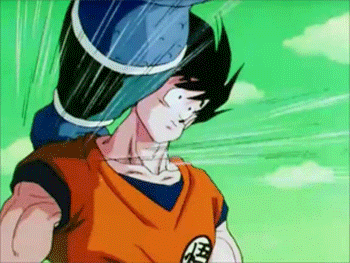
So you've probably gotten to this point and asked: "Why a tournament arc though?" And I will preface my answer with this: I'm not super-certain if the timeline lines up as well in my head, so if anyone can correct me on this, feel free to comment or message me on this if I'm wrong.
My answer is that there are two series responsible for this: Dragon Ball and Street Fighter. See, Dragon Ball Z would also be airing around this time, and if I'm thinking correctly, it should be airing around the time of the Cell Games arc (I think; Again, please correct me if I'm wrong). And remember, Dragon Ball is one of, if not the, most influential shounen battle series of all time. Add onto that the sudden success of Capcom's Street Fighter with the release of Street Fighter II and its colorful cast of characters from various nations with colorful attacks, and you can definitely see why Bandai would want to get in on the trend.

Would it surprise you if I told you that one of the more influential series for G Gundam was also Saint Seiya (or Knights of the Zodiac for those more familiar with its western name), specifically when it comes to the concept of the golden super mode. I also would not be surprised if Saint Seiya was also the reason for the majority of the Shuffle Alliance members being HOT MEN. Then again, Gundam's success was kickstarted thanks to women, so it may also be a treat for the ladies.
What's Going On in the World (1994 Edition)

So enough about Shonen Jump series and Street Fighter. What about the rest of the world? As we all know, media is informed by the world events that unfold as it's being made, and G Gundam is no exception. And while not all of these events happen before the series starts to air, they do, in my opinion, help to either inform or reinforce the ideas and themes present in Mobile Fighter G Gundam. I won't say what those themes and ideas are in this video, but here's an incomplete list of what is going on in the world before and during G Gundam's run:
The Japanese economic bubble bursts in 1992.
To reflect that, Patlabor 2 releases in theaters in 1993, best exemplifying the more pessimistic tones of post-bubble Japan by giving us a much colder and more cynical version of Patlabor that contrasts heavily to the more optimistic tone the series had prior to Patlabor 2.
Furthermore, a lot of western countries would be suffering from recessions at this point in the 90's. To put things into context for Americans, the economy is a large part of why Bill Clinton beat George H. W. Bush in the '92 Election.
In terms of entertainment, two extremely iconic series are still being worked on during G Gundam's airing: Pokemon and Neon Genesis Evangelion.
The general public is more aware of the climate than ever before, especially since it had been about 9-10 years since scientists discovered a hole in the ozone layer directly above Antarctica.
A week after G Gundam begins airing, the Rwandan Genocide begins in earnest.
Before their infamous Tokyo Subway Sarin attack, the cult Aum Shinrikyo would pull off a smaller scale Sarin attack in Matsumoto.
Just for fun: Magic Knight Rayearth airs in October of '94. In my mind, Rayearth acts as a sort of distaff counterpart to G Gundam due to their primary audiences.
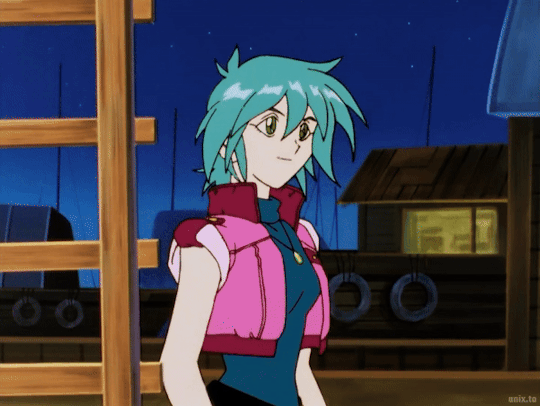
And that's a wrap. I hope this more scattershot dive into some Context TM was interesting. This is going to be on the exam, as next time I will finally be talking about Mobile Fighter G Gundam
#anime and manga#mecha#mobile fighter g gundam#anime history#mobile suit victory gundam#a wild daisuke sakaguchi appeared#saint seiya#knights of the zodiac#street fighter#street fighter ii#dragon ball#dragon ball z#dbz#japanese economic bubble#giant robo ova#ajikko-san#yasuhiro imagawa#mobile suit zeta gundam
17 notes
·
View notes
Text
Getter Robo Retospective - Getter Robo Part 1 -Ryoma Nagare
So, Iv’e been wanting to do an overall retrospective of the Getter Robo manga franchise for a while now, and since the Getter Robo Arc is nearing it’s finale as of the time of this writing, and will either give it a definite ending, or be the final nail in the coffin that the series will never be finished before Getter Robo falls into public domain, I thought now might as well be the time to do it.
As such, I’ll be doing an overall analysis over the entire collection of Ken Ishikawa’s Getter Robo manga series, it’s plots, themes, characters, and covers the various ideas this crazy and amazing sci-fi series covers.
Also, this retrospective will NOT cover the various anime adaptations, or the behind the scenes stuff that has gone on with Getter Robo over the years, such as Go Nagai being credited as the writer of the original manga despite only having come up with the overall concept and designs for it(the rest was by Ken Ishikawa), or the way that Ken went back and added in some extra chapters in the original two manga to explain some things and to tie the early manga more closely into what came after.
For the purposes of this retorspective, I will be focusing exclusively on the manga itself, and what it has to offer, without going into anything else.
And of course there is no place better to start, than the beginning.
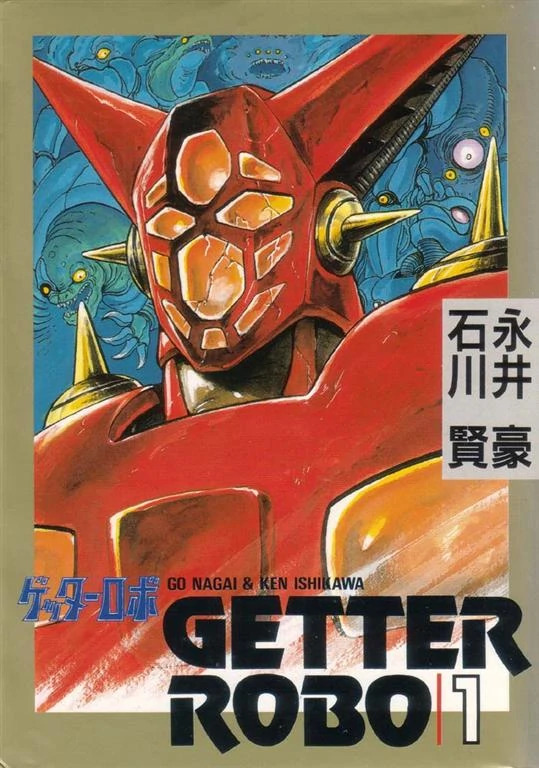
So, what is the story of the original Getter Robo Manga?
Well, the overall plot of the original manga is about the conflict between two sides of a conflict, as laid out rather well in it’s prologue chapter.
The first is our protagonists, the Saotome Institute of Japan, who’s leader and namesake has invented the titular giant mecha, the Getter Robo.
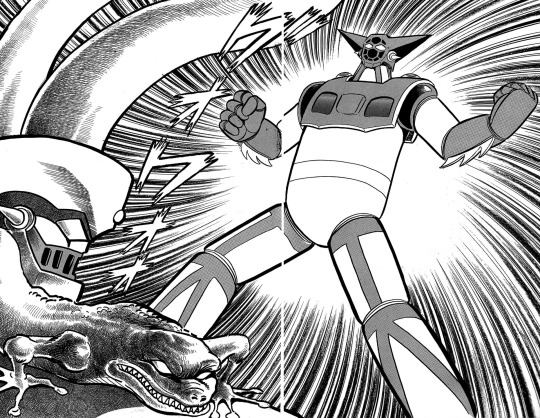
Powered by a revolutionary newly discovered form of energy called “Getter Energy”, this enormous metal behemoth is a fighting machine unlike any other.
This war machine was originally supposed to be used for space exploration, but due to necessity, it has instead been reworked into a fighting machine.
It’s only weakness is that it requires 3 different living pilots to operate it to draw upon its full strength.
Opposing the Saotome Institute, is the forces of the Dinosaur Empire
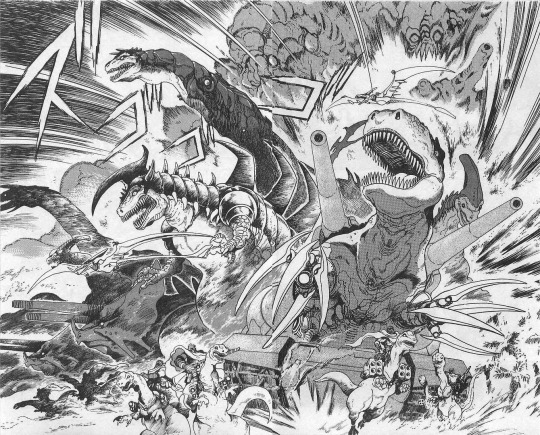
An empire of humanoid Sentient Dinosaurs that long ago was forced to flee the Earth’s surface after it was bombarded with a strange kind of energy from space that was deadly to their kind, their only way to survive being to use their incredible technology to hide on the only place on Earth where the rays couldn’t reach them. The Earth’s very core.
Now, after millions of years underground, and the rays that forced them beneath the earth to begin with having seemingly ceased, they have finally returned to reclaim the earth’s surface for their own. At it’s disposal, it has incredible technology, and giant cyborg dinosaur monster in it’s quest to wipe out the newcomers, the human race, to achieve total dominance over the Earth.
If you think this premise sounds very generic, and you’ve seen it in some form or another in countless other Mecha series, you are not wrong. Ancient evil group attacking the protagonists, and only the new giant robot can stop it, probably the biggest stock plot in mecha overall, having been done in everything from Neon Genesis Evangelion to Megas XLR in some form or another. The set pieces and details are different, but the overall plot is the same.
However, where Getter Robo fits into this, is that it was one of the first giant robot manga there was, and many, many of the tropes and ideas it pioneered would be used and imitated by its successors.
In fact, I would argue that Getter is the second most influential mecha series in history, only second after it’s big cousin, Mazinger Z.
However, we are not here to detail how it influenced the manga industry, but how Getter holds up on it’s own, and in this regard, despite having a plot that has been overused time, and time again by it’s successors, this isn’t really that much of a problem for Getter Robo. Because like any good Mecha series, Getter’s biggest strength is it’s cast of characters.
Starting off in chapter 1, we are introduced to the first of the Robot’s giant pilots.
Ryoma Nagare.
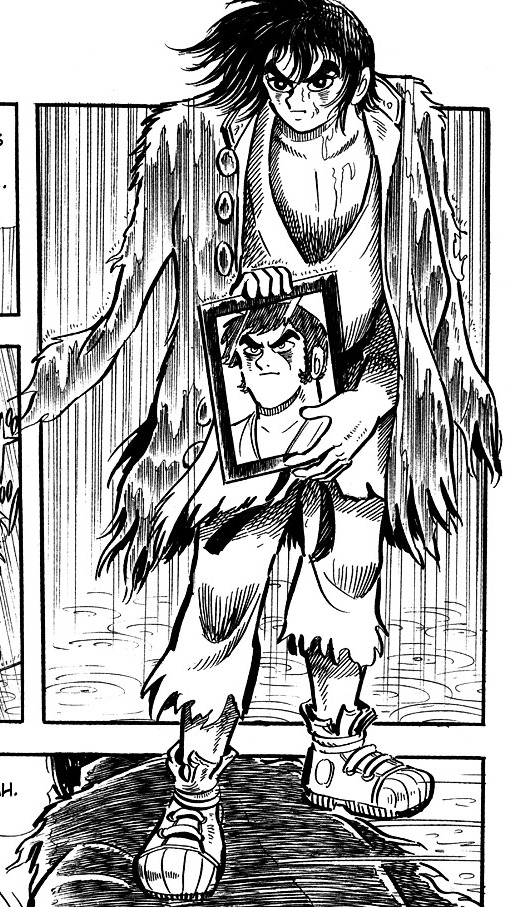
Each of the pilots of Getter Robo is given an introductory mini-arc to set them up, and Ryoma’s is easily the best of the 3.
We are introduced to the main character of most of the franchise at a very unusual spot to open a main character, especially for a Shonen protagonist.
At the end of a revenge story.
To put it bluntly, Ryoma does not start off this series as a particularly likeable, nor good person, as his introductory scene is him crashing a perfectly legal martial arts tournament and beating the everloving shit out of it’s referee, it’s participants, and the judges who arranged it.
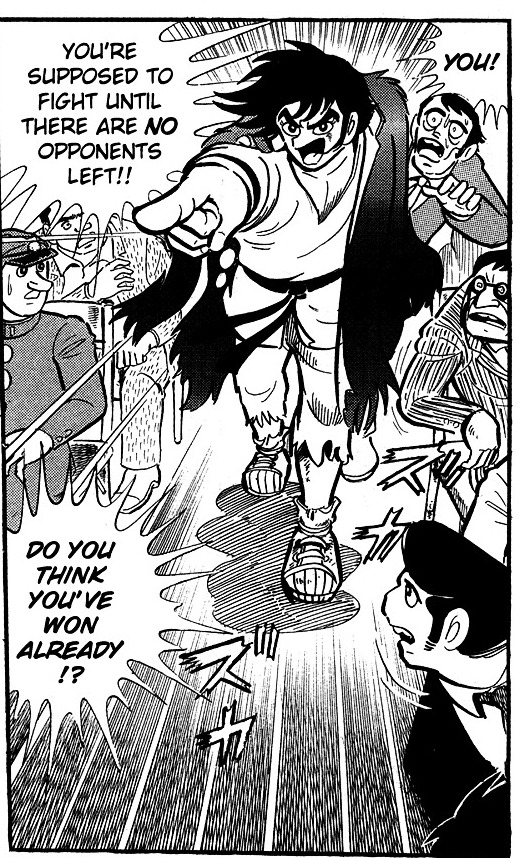
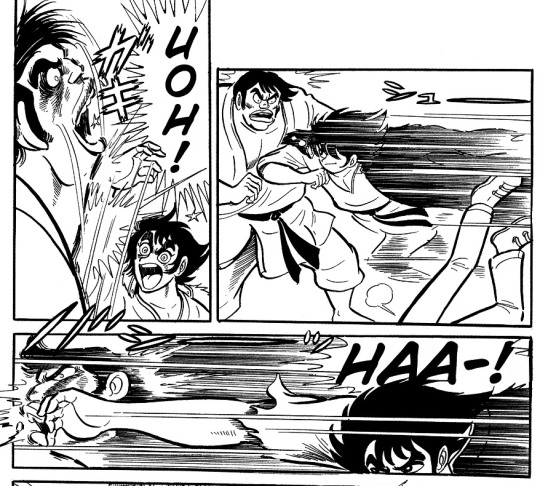
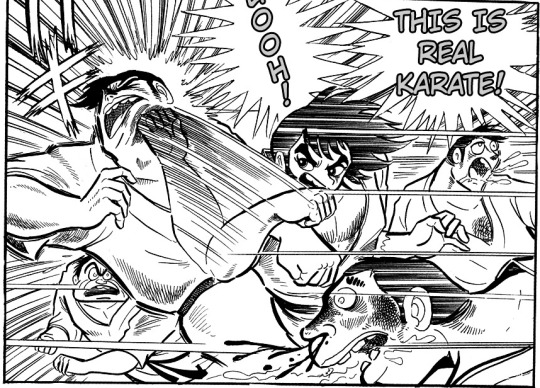
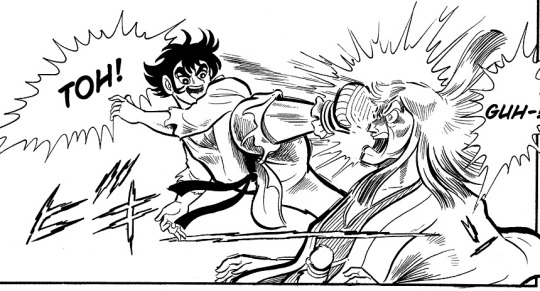
His reasons for doing all of this?
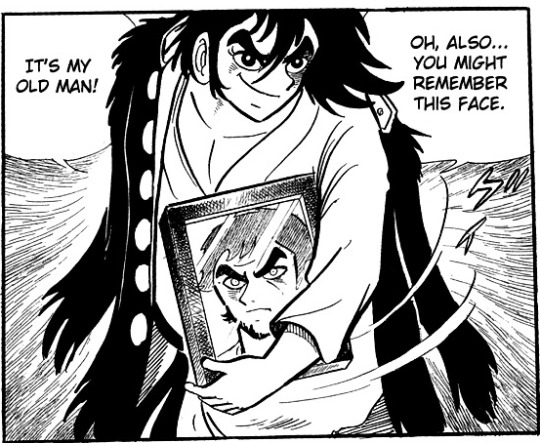
Revenge for his old man.
As it turns out, Ryoma had a massive beef with the arrangers for this contest, as his father, Ichigan Nagare was a pro karate champion back in the day, whose reputation was purposely destroyed by those arrangers.
Now he’s come to take revenge by utterly crushing their disciples on national television, to hammer in the point that his father’s martial arts was superior to theirs for all the world to see.
During this whole thing, we also get a very good look into how Ryoma thinks at this point in time.

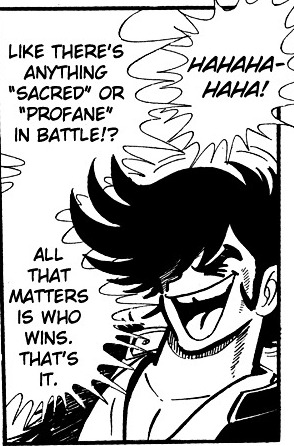
When the arranger tries to appeal to the “Sacredness” of the Sport to get him to stand down, Ryoma laughs in his face, proclaiming that there is nothing sacred about combat at all. The only thing that matters is who emerges as the victor.
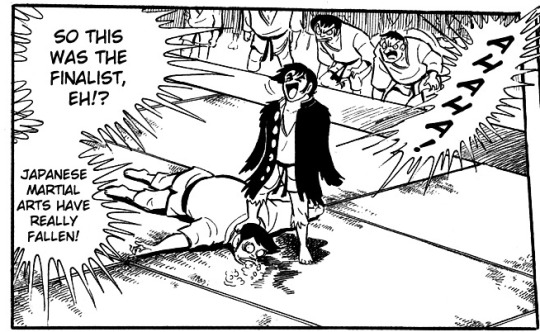
This is backed up by how he doesn’t show the least bit of compassion or honor to the first of the contestants he defeats, easily smashing him to the ground then gloating over him after having demonstrated the sheer difference in the combat prowess between the two of them.
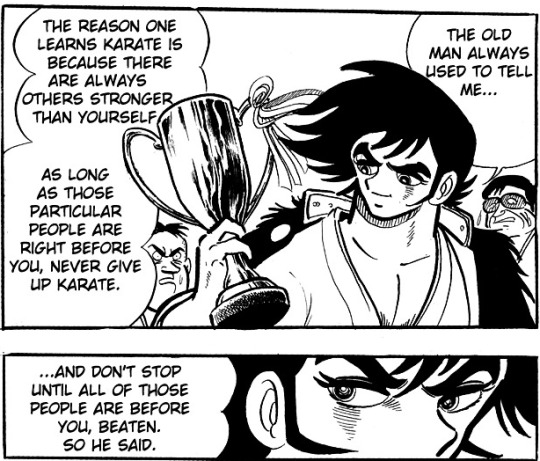
He is very blunt about the fact that he believes that one should pursue strength for strenght’s sake alone, and never stop until you have crushed anyone who stands before you. Always train to get stronger, and always seek out those who can challenge you and beat them too.
Might makes right.
This is a REALLY good introduction for showcasing Ryoma as a character. How he thinks, his immense near superhuman strength, his ruthlessness, his pride in his own strength.
It also ties in directly into the themes of this series, as this kind of thinking is essentially Evolution itself boiled down to it’s bare core. The survival of the strongest. What is the point of Evolution after all, if not this? Those with the traits to survive and thrive will do so, while those who cannot, will be crushed by those who can, who in turn will pass down what made them successful to begin with.
Of course that is not what the actual message of this series is, but it is a concept that this series is rather blunt about, and it’s not a coincidence that the most prominent of all the main characters of this series began his journey while believing wholeheartedly into that ideal.
All in all this scene is just great, and it sets up Ryoma really well, as well as making it clear that this is a boy who has a lot of growing to do as a person.
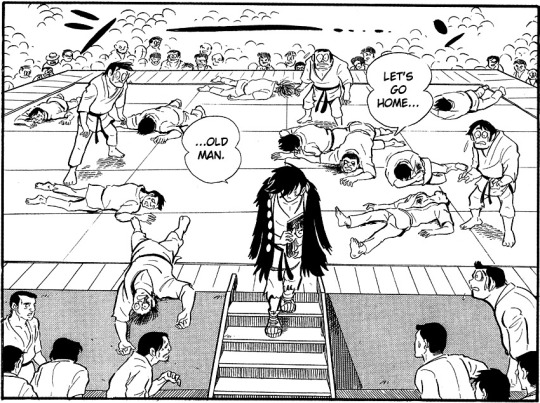
And so, having achieved his life’s work that he’s trained for for years and years, Ryoma nagare quietly leaves the arena, leaving behind a dozen bruised, battered and broken men on the ground.

Of course this display of power has not gone unnoticed, as in the audience were two men from the Saotome Institute who came here hoping to find someone strong enough to pilot their giant robot.
As it happened, they just found one that fit the bill rather spectacularly.
Then in the next scene we are showcased Ryoma’s home.
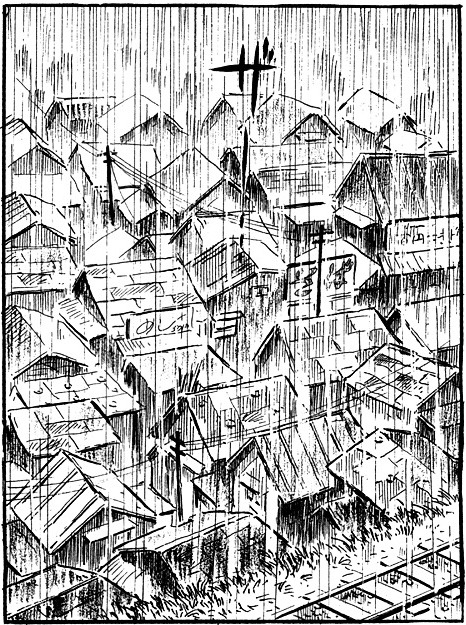
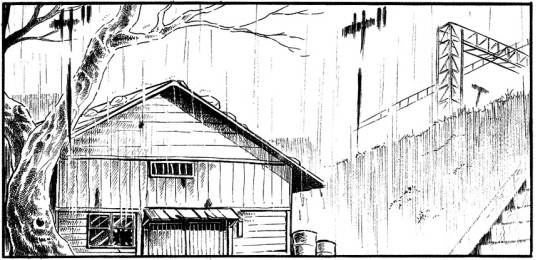
Ryoma Nagare, a fighting genius that at the tender age of 16-17 smashed the greatest karate practitioners in Japan with ease while being outnumbered a dozen to one, lives in a ramshackle part of town, in a rundown old building that has broken windows, a leaking roof, and can at best be called a ramshackle cottage.
It’s a rather brutal contrast to the sight of the prestigious, well made and maintained karate tournament building we were just in.
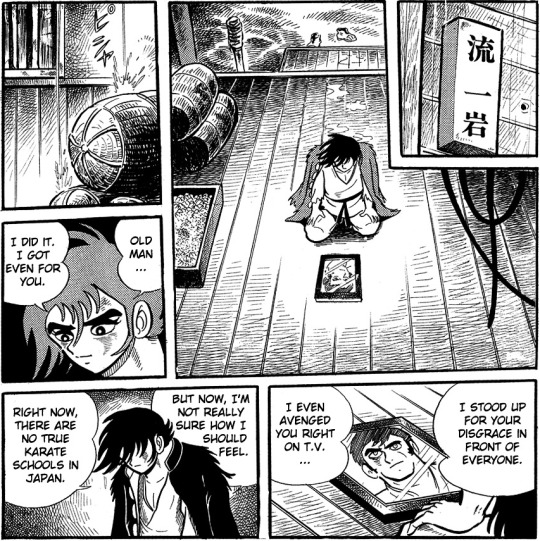
Inside we find the sight of something else rather unusual for a Shonen protagonist. Having now achieved his goals, and avenged his father’s memory, Ryoma is slowly starting to come to the realization that this has all been one giant waste of time. He hasn’t actually earned anything on this journey. His father is dead, he’s still poor, and his only belongings is this shitty building and the clothes on his back.
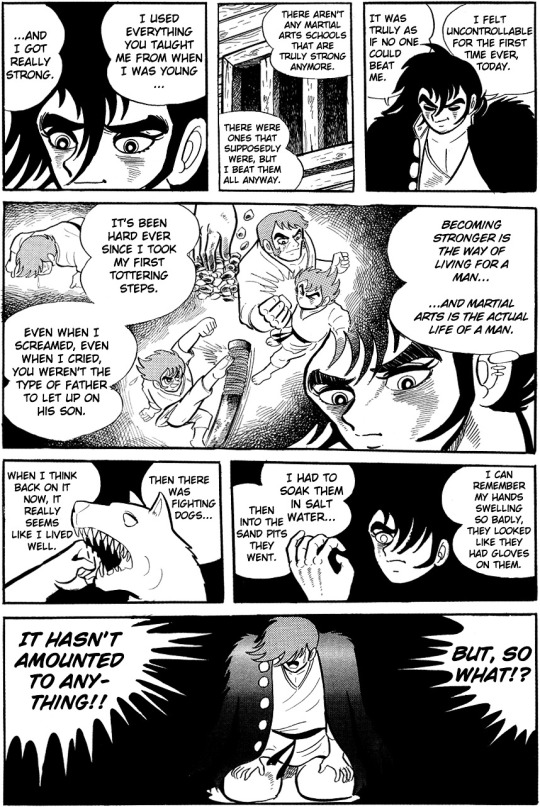
As we learn here, Ryoma has spent his entire life being trained in martial arts, to insane degrees even for an adult man, much less for a child. All for the purpose of one day doing what he did today, and avenging his father’s memory.
This scene really hammers in the fact that for all his ridiculous strength, Ryoma is a child, and he has a child’s way of looking at things.
He thinks back fondly on being pitted against stray dogs in death matches, and he reveals here that in his mind, this was all about “Redeeming” martial arts somehow, as if this display would really change anything in the grand scheme of things within the sport.
It wasn’t of course. This was all about revenge. Everything Ryoma ever trained for was for this moment, this moment of what should have been absolute and total triumph as he achieved a truly spectacular victory and proved his father’s fighting style the best in all the land and he has proven that he himself is the strongest fighter in all Japan.
Instead he is coming to the realization that so many people that wasted their lives on vengeance have come to over the years. That it was all a giant waste of time.
Revenge is a suckers game.
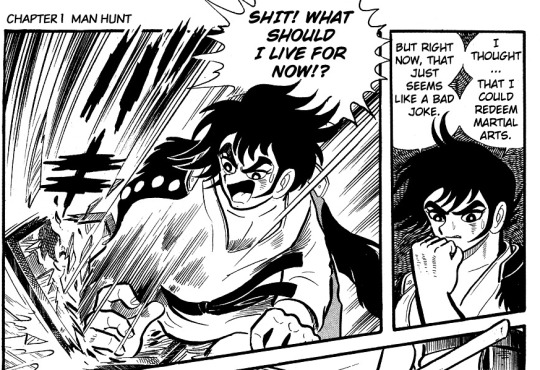
Having achieved his goals, Ryoma has found them to be completely empty, and has nowhere to go. This is a really fascinating way to open up a character arc, as usually a character that learns the lesson that David Xanatos knew so well, happens either at the end, or somewhere later down their line. Ryoma however, learns it in the very first chapter, and now has to find something else to live for.

However, his soul searching is then interrupted by a few gentlemen from the Saotome institute.
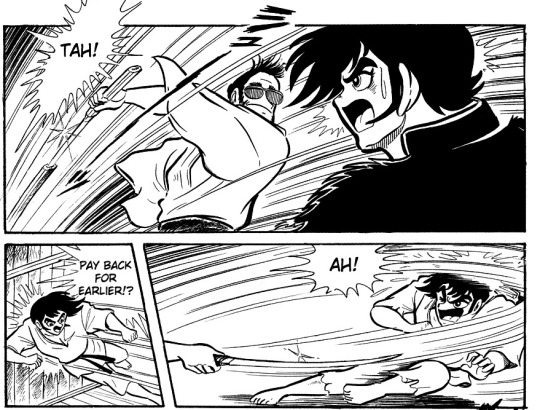
Who immediately tries to kill him.
Now before I discuss the next part, I wanna praise this overall scene, because it really works great within the context of this chapter.
Ryoma has been introduced as a massive asshole, who firmly believes in the mantra of Might makes right, and he doesn’t feel any regret at having brutalized a dozen of innocent people, just the fact that he realizes that there was no real satisfaction to be had from it. Now the other shoe drops, and HE is attacked in his own home, completely unprovoked for reasons that frankly he has no personal involvement in on his own side. While this attack does have an in universe reason behind it, it main purpose is that it serves as a nice cathartic moment for the reader, as while he’s never going to legally punished for what just happened at the tournament, he is punished by the narrative for his actions, which is something i’ve seen far, far too many stories do over the years fail to do with asshole protagonists.
It also serves to put Ryoma’s current belief in Might Makes Right to the test. After all, aren’t these men doing exactly what he said that those who practice martial arts should do? Seek out those stronger than them, then crush them.
All of this makes it a shame that it is horribly undercut by the one, genuine stain on the original manga. Namely that one of the attackers is this guy.
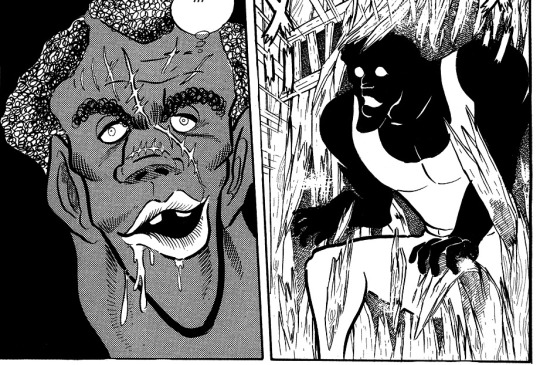
And it’s at this moment you realise, oh yeah, this was made in 1970’s Japan. The unfortunate fact is that Mangaka of this period generally based their depiction of black people on early American comics(Which had plenty of this kind of artwork), and Ken Ishikawa was unfortunately not an exception to this rule.
He would THANKFULLY not repeat anything like this later down the line(his depiction of black people is far more natural and realistic in later manga), but hot damn is it both uncomfortable and distracting to read the pages with this guy. And it’s a real shame too, because frankly, not only is the following fight scene very good as a narrative punishment for Ryoma, but it’s just a good fight scene in general.
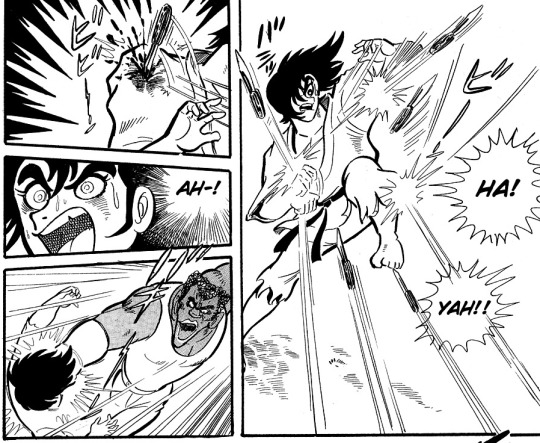
Unlike the Tournament fight, which was mainly a beatdown to establish Ryoma’s ridiculous strength, this is an actual fight, which showcases Ishikawa’s ability to draw energetic, exciting fight scenes where action flows very naturally.
It also shows that for the kind of ridiculous strength Ryoma possess, he isn’t some superhuman, as early in the brawls he’s heavily wounded by the rather mundanity of taking a throwing knife to the shoulder. This is in general something that makes action if Getter Robo stand out from other shonen series too. When characters, or Robots for that matter, takes hits, they rarely shrug them off with no problem, instead taking real, genuine damage that doesn't just instantly go away. They might power through them, but that isn’t the same as them disappearing into the ether.
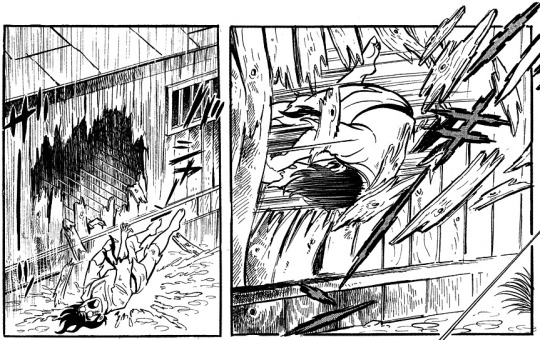
In any case, the battle ends up outside the house when Ryoma is thrown through the wall.
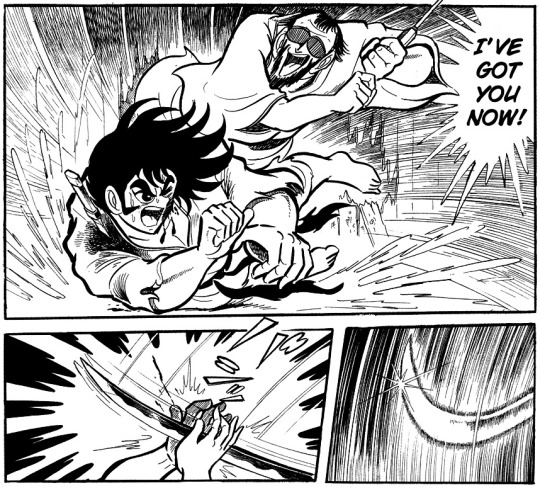
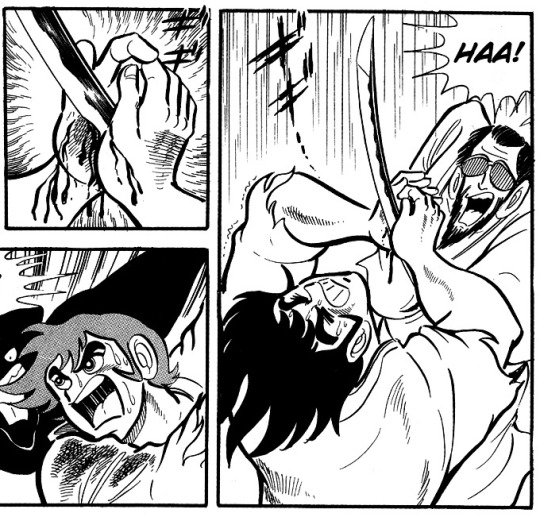
He’s then forced to do the classic, catch the blade between the palms of his hands trope, which is depicted much more believable than most cases I’ve seen, as despite succeeding, it still left him bleeding from those palms.
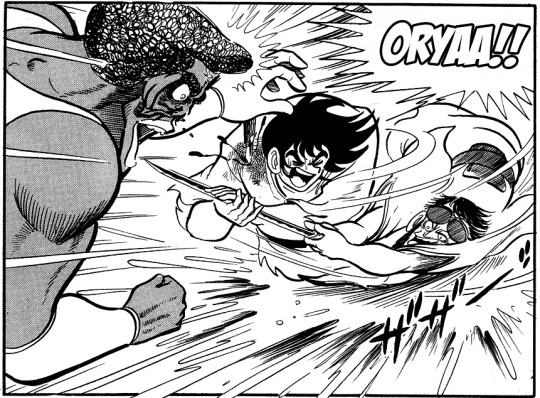
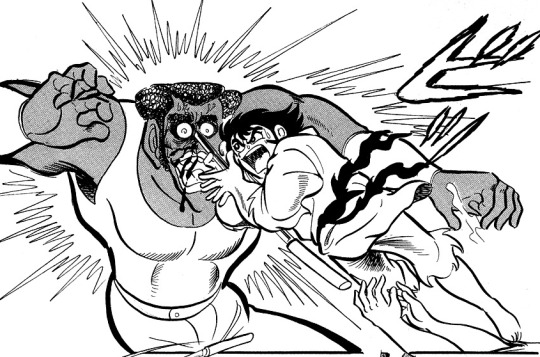
Ryoma then redirects the blade into the big guy who is attacking him from behind, killing him. I really love how the artwork sells that this is a desperate move on Ryoma’s part. He is genuinely fighting for his life here, and he’s pulling out every trick he has to to win despite his wounds.
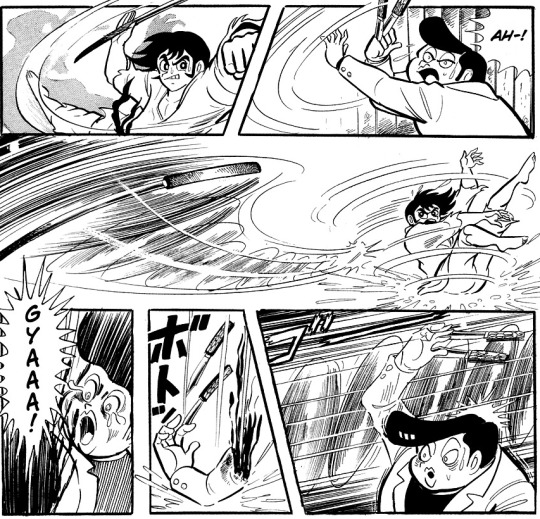
He then follows that up by ripping the blade out, and throwing it at the knife thrower guy. I also like that after doing so, he immediately falls flat on his ass, in a rather realistic manner(he is fighting in the rain after all, so the ground is undoubtedly pretty slippery.), while also showcasing the force of the throw. My only main complaint is that for this one panel Ken forgot to include the wound and the knife on his shoulder, as I think it would really sell just how desperate Ryoma is here if we’re visually reminded in the moment that, oh yeah, he’s powering through and using the arm whose shoulder has a knife in it to to throw this thing.
Thankfully, that missed opportunity for visual grittiness is more than made up for by the next part.
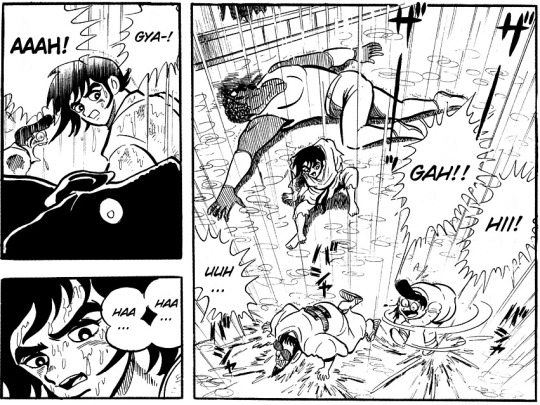
Having now effectively won the battle(I think the swordsman broke his foot in the fall, at least that’s how it looks), Ryoma suddenly realises that, holy shit, he just killed someone. The contrast between here and how he looked as he challenged the tournament fighters couldn’t be more different. The cooky, arrogant youth is completely gone, and you're reminded that Ryoma is just a kid. A kid who just had to kill someone. The bravado is completely gone, leaving only a kid who is tired, confused, in pain, and probably pretty scared.
He is then approached by the man who just had 3 grown ass men jump and attack him, Dr. Saotome.
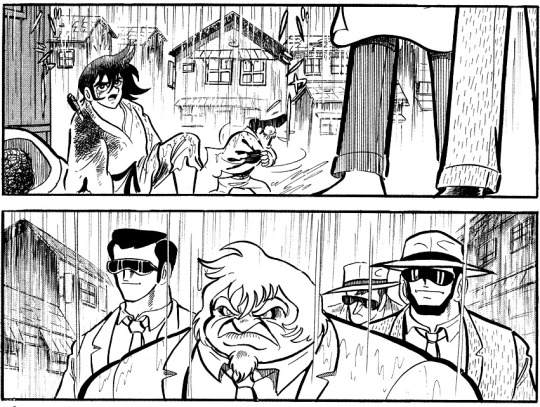
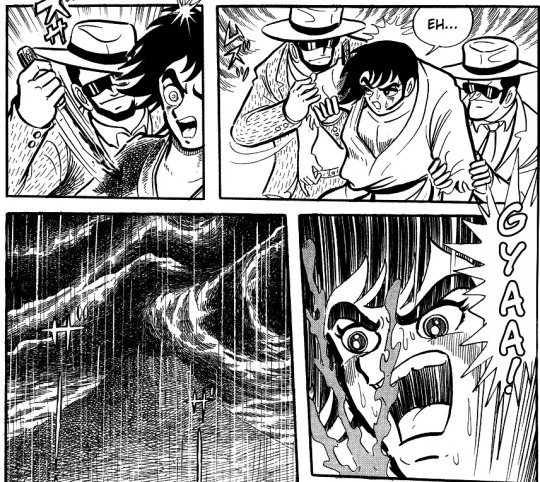
Wounded, and mentally exchausted as he is, he is in no position to argue as Saotome declares that Ryoma is what he’s been looking for, and as one of his men rips the knife out of his shoulder, Ryoma screams before losing consciousness from the pain. Afterwards he is dragged into a car, and bandaged up.
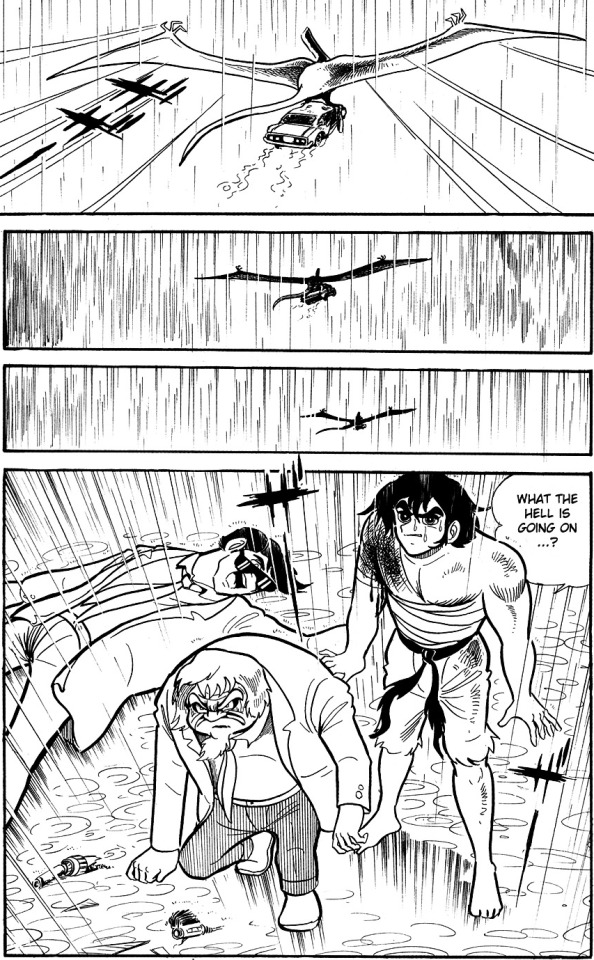
Then as they're driving, the’re attacked by a giant flying dinosaur that grabs unto the car and flies away with it, Ryoma and Saotome barely managing to get out in time, alongside one of Saotome’s unlucky goons who breaks his neck in the fall.
And so ends Chapter one of Getter Robo.
All in all, other than the horribly racist black guy, this is a really good first chapter, that sets up Ryoma Nagare really, really well, showcasing his way of thinking, his origin, and where he needs to grow, while also showcasing his ludicrous strength, and that he is fully capable of going balls to the wall to win a fight, which will be showcased many, many times in this series. It also ends on a reminder of the fact that oh yeah, this is a series about one side vs dinosaurs, as Ryoma gets his first introduction into the enemy he will be fighting time, and again in this manga. It also gives a distinct first impression of just how ruthless Saotome is, as he is perfectly willing to send 3 dangerous goons on a teenager just to test his prowess in battle, which is absolutely going to come into play in future chapters.
All in all, it’s a good start. Not an amazing beginning, but certainly a good introduction to our first main character.
40 notes
·
View notes
Text
Robot Carnival Review
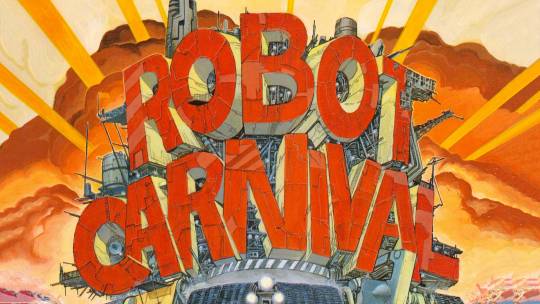
When I first started my blu-ray collecting kick, Discotek was hyping up their release of Memories, an anthology movie organized by Akira’s Katsuhiro Otomo. While doing research on it, I saw it was recommended in the company of Robot Carnival, another anthology movie Otomo was involved with, with more animators and thus individual shorts, and a unifying theme of “robots”. As a robot enjoyer, I figured I couldn’t go wrong with this, and I was right! This was a joy from start to finish, where even the weakest segment still had plenty to offer. If this sounds like it might be up your alley, it’s available to stream for free on RetroCrush and YouTube!
Additional note before I get into talking about each short individually: with the exception of Cloud, the music for every short was composed by Joe Hisaishi, who has way more range as a composer than I would’ve ever expected, considering I knew him exclusively as the Studio Ghibli composer. Additional additional note: I watched the anthology in the original Japanese order, the version on RetroCrush and YouTube uses an alternate order from the international release.
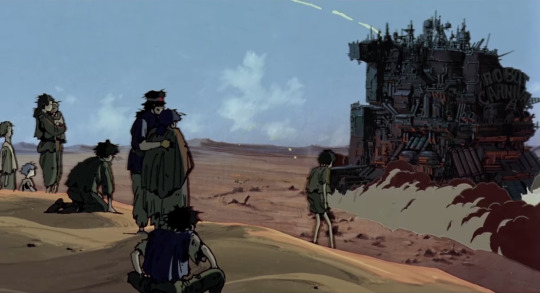
Opening/Ending (Katsuhiro Otomo, creator of Akira and Atsuko Fukushima, key animator on dozens of anime projects, including Akira) - A mobile fortress (literally the above Robot Carnival logo) traverses a post-apocalyptic wasteland, bringing death and destruction wherever it goes. The Opening sets the bar for what you should expect going forward in terms of production values, and the Ending is a nice send off for the whole thing, but I don’t really have much else to say about these shorts.
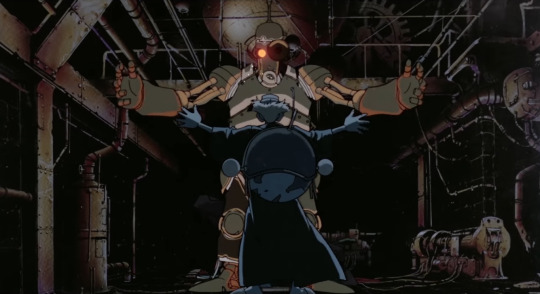
Franken’s Gears (Koji Morimoto, Director of Memories: Magnetic Rose) - A mad scientist attempts to bring their robot to life, succeeds horribly. I think of all the shorts in this movie, this one has the most impressive mechanical animation. The whole thing takes places in the scientist’s lab, and the emphasis really is on all of the ways the environment is struggling to bring the robot to life, to the point that once it does so, it begins to crumble and break apart. But the animation on the scientist himself is also really charming; the way he moves almost makes him look gooey, which is apt because my sister pointed out he was probably designed after a snail, what with the big orb on his back.
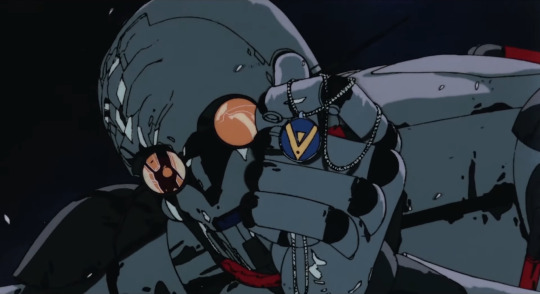
Deprive (Hidetoshi Omori, Animation Director for Char’s Counterattack) - A super android has to mamoru his imouto from an invading alien robot army. One of my favorite shorts in the anthology, this was an entire action movie expertly condensed down into not even ten minutes, complete with an awesome soundtrack. I’d actually go so far as to call this one perfect for what it is, but it’s not much more than that.
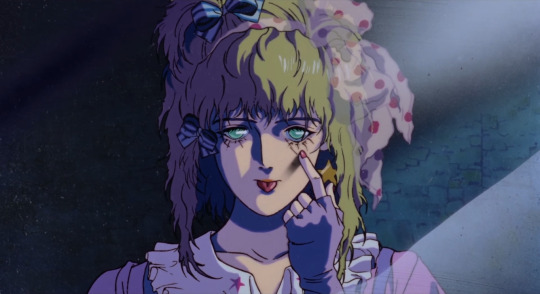
Presence (Yasuyomi Umetsu, Character Designer and Chief Animation Director of Megazone 23 Part II) - A man builds an android for companionship, and he gets more than he bargained for. Longest piece in the compilation by a mile, and the first one with voice acting. Despite enjoying some of the other shorts more, I think I would call Presence the “centerpiece” of this anthology, as it’s definitely the most story-rich. It even has some prescient worldbuilding: the people of this setting do not see robots as sentient beings, which is shown right at the start when a bunch of kids knock the head off of an android and play with it while absolutely no one in the crowded plaza reacts. This sets the tone for the main character’s interactions with his creation, and provide additional context for the things he does besides the obvious explanations.
This was also the first short where I noticed something off about the animation, where it seemed to animate too well in for certain movements. As it turns out I was right; the liner notes explain that the director was using this project to experiment, and he would animate different movements on different frame counts. It’s not terrible, but it is a little distracting to see how smoothly something like a simple head turn will animate while more complex motions look more standard. Also, unrelated but fun coincidence: the liner notes also explain a reference in the script to a story called Daddy Long Legs, about an orphan girl who receives funding from a wealthy philanthropist she never meets, which explains a reference that went over my head Yakuza: Like a Dragon.
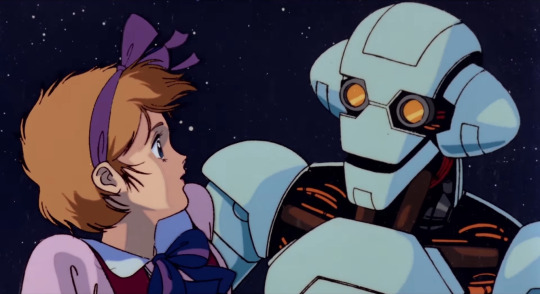
Star Light Angel (Hiroyuki Kitazume, Character Designer and Animation Director for Mobile Suit Gundam ZZ and Char’s Counterattack) - What could have been the most effective piece of robosexual propaganda ever made: a girl and her friend are at Tokyo Disneyland ROBOT WANDERLAND and are having a wonderful time, until she discovers that her boyfriend is cheating on her, at which point she retreat into the park and winds up on a virtual reality ride. Meanwhile, a robot performer attempts to find her and return the locket she dropped while she ran past him. This is tied for my favorite, alongside Deprive, because I’m a big sucker for romance and the main song for the short is so perfect for the content. I was also delighted to find the explanation for this short was that Kitazume, who’s work up to this point was all mecha anime like Aura Battler Dunbine and Zeta Gundam, really wanted to try to flex with character expressions, and it came through brilliantly as the range and level of facial expressions was the first thing I really took notice of in this. Funny enough, though, Kitazume also apparently said he considers this and Deprive to be the weakest pieces of the anthology, and I suppose he’s right in that they have the least meat on their bones and are also probably the least technically impressive, but still: my two favorites!

Cloud (Mao Lamdo, a prolific animator on many projects, but probably best known for this) - A robotic boy wanders past a series of ever-changing clouds. Cloud is definitely a stand-out short for a number of reasons, from the way its animated to the incredibly tangential connection to the “robot” theme, and to be perfectly honest I got a lot more out of it after I read the liner notes. The short was adapted from a self-published book Mao Lamdo had written years prior that had nothing to do with robots, and his interpretation of the short and the change to making the main character a robot was that it represented his frustration with the trend in the anime industry at the time trending towards a being obsessed with the mechanical world, while he still preferred to draw and animate nature. As I mentioned at the top, this is also the only short to not have music composed by Joe Hisaishi, instead the piece used is by Isaku Fujita, and as far as I can tell, this is his only credit. Still, it’s a good credit to have; Lamdo said the song evoked the idea of having a conversation with God and asking the big questions, which I can completely see.
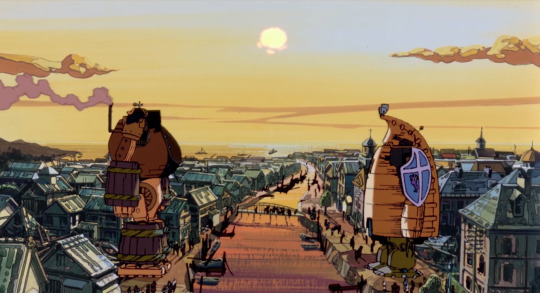
Strange Tales of Meiji Machine Culture: “The Westerner’s Invasion” (Hiroyuki Kitakubo, Director of the JoJo’s Bizarre Adventure OVA and Golden Boy) A terrible steampunk mech invades a Japanese town, and is warded off by a team of youths piloting their own terrible steampunk mech. I watched this one with the English dub first and then again in Japanese because it’s been a fuckin’ minute since I heard a dub this racist, complete with changing r’s to l’s and vice versa, only to be cracked across the skull by what I am certain was a Japanese man doing his very best to phonetically read English in the Japanese version. In spite of that, though, this is easily the funniest short for all the right reasons, and it kinda clicked once I found out that the director was also responsible for Golden Boy; it’s that exact kind of humor, complete with a protagonist who could very well be Kintaro Ue’s ancestor.
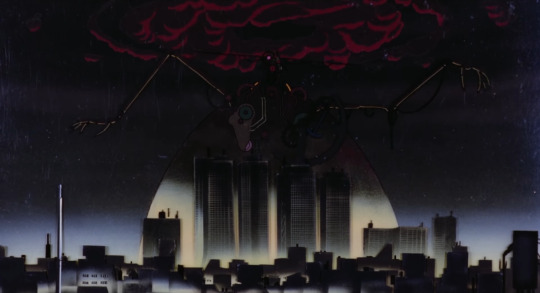
Chicken Man and Red Neck, a.k.a. Nightmare (Takeshi Nakamura, director of Catnapped! The Movie) - A robotic magician wreaks havoc on a city by transforming everything in sight into robotic monsters, and a vagrant gets caught up in the chaos. I initially wrote down “this one has the energy of a Don Bluth movie, particularly In the Dark of the Night from Anastasia”, although the liner notes say he actually was inspired by Night on Bald Mountain, which is definitely a more flattering inspiration and more accurate, to boot. I think of all the shorts in this anthology, this one gets the prizes for “best overall animation” and “best use of robots”, and it also has the most intense PS1 RPG sounding music, which once again speaks to Joe Hisaishi’s talent as a composer for doing that a full decade before the PS1 even existed. Also, fun trivia, the director turned down an offer from Hayao Miyazaki to be animation director on Castle in the Sky to make this, which… was maybe not the best career move, but still this was a terrific short and I’m glad to have it.
Again, the movie is easily accessible for free streaming, and I’d heartily recommend you check it out if you haven’t already. But if you’re into collecting physical media, the blu-ray is crammed full of tons of goodies, including the liner notes I’ve referenced, art galleries for each segment, and a lot of other production materials. Discotek also announced they’re doing a 4k UHD release of this soon, which won’t include all the extras due to the way UHD discs work, but I gotta be honest, this would be worth double dipping for if the resolution bump is noticeable enough.
5 notes
·
View notes
Note
hey! i noticed that you’ve written a lot about how voltron fails as a mecha series, and it got me curious about what a GOOD mecha series looks like. do you have any recs for someone whose only experience with the genre, quite literally, is voltron?
note: that is NOT where I wanted the cut. who knows what the devs are doing over there at tumblr hq.
-----
Welp, there’s more than one kind of mecha. There’s super robots -- where (in general) the robots are ultra-powered and relatively indestructible. Then there’s real robots, which will break down and/or run out of ammunition at the most dramatically critical moments. And then there’s a category that at best might be nearly-sentient robots, which have minds and motivations of their own -- but I wouldn’t say that’s a true category (in terms of the genre) so much as a distinction I've noted.
I’ve never been big into the super robot series (with a few exceptions), and I mostly find the combining robot genre to be frustrating. Former mechanic and engineer who currently works with AI, so a lot of the hand-wavey aspects are frustrating for me, especially in super robots where things mysteriously repair themselves and there’s never a struggle to upgrade/repair. (And don’t even get me started on the idea of controlling a bipedal reactive machine with only two foot pedals and a damn joystick.)
Which is all to say, I suppose I should recommend that you watch the classics, except I’m not really sure what they are because I’ve forgotten most of them. And frankly a lot of them are really shoddy animation by today’s standards, and life is too short to waste time on that. I’ll need to refer you along to other mecha fans to add their recommendations, instead.
Well, I can at least recommend Gundam and Macross, but that’s kind of like saying I recommend Doc Martens and Aididas -- that barely narrows it down, since there’s so many options within each brand. Everyone’s got their favorites in each, as do I, but any mecha series that’s stayed with me is one that found a way to either twist the core trope, or explored implications that other series glossed over.
Note: I’ve never seen any version of Eva, and never felt the urge to, either. Sorry. Ask someone else for input on that. Plus there’s also ones I’ll leave off here ‘cause they’re veering over into AI/robots/tech and less what would usually be called mecha, but they’re still worthwhile: Battle Fairy Yukikaze, Ghost in the Shell: Standalone Complex, Broken Blade, Last Exile, and Voices of a Distant Star all come to mind.
Gundam
For me, I adore the technical geeky touches in Gundam F91, but the story is total spaghetti, so you might want to skip that until you’re more familiar with the gundam tropes. (It was meant to be a series, iirc, got shut down, and they took the pieces and made a movie from it, so it’s... kind of compressed, to put it mildly).
Gundam Wing and Gundam 00 are considerably less geeky on the technical (though they do satisfy the mechanic itch, with a bit more real robot, at least on the technicalities). I like the international core cast, and the way each series explores geopolitical dynamics. (That said, skip the second season of Gundam 00. It just goes totally off the rails into some really wild and wacky directions.)
A long-running concept like Gundam is recognizable across the series thanks to core concepts, and in Gundam’s case it’s the conflicts between imperialism and colonialism, war versus justified rebellion, and pacifism versus a first-strike as self-defense. What I liked with Wing and 00, in particular, was its central pilots felt more tied to (and aware of) the political ramifications of their actions.
I did watch about half of Iron-Blooded Orphans, which struck out in a new direction by having Mars as the colony instead of the lagrange points, but didn’t bother finishing. From what I hear, watch it with a box of tissues, as it’s a return to the classic kill-em-all perspective of the original Gundam series.
Macross
I’m sure someone else will tell you to watch the original Macross (the american version being Robotech, albeit highly edited). I know lots of people adore the first Macross series, but it’s just too late-80s for me. (The hair, my god, the hair.)
Personally, I prefer Macross Frontier -- the amination is much improved, though the fact is I also adore the voices of Yuuichi Nakamura and Aya Endō. Macross has some politics, but it’s mostly internal -- that is, the opponents aren’t human, so whatever debate there is about who’s right or wrong is mostly one-sided, since we only ever see humans doing the talking.
I tried to watch Macross Delta but it just didn’t do it for me -- and therein lies some of the issues (for me) with both Gundam and Macross. Because both have some core elements that they tackle in every series, it can start to feel a bit repetitive.
For Macross it’s always music, Valkyries (the mecha type for Macross), and a love triangle -- which sometimes isn’t even resolved. (I’ve read all kinds of debates about whether Alto ends up with Sheryl or with Ranka, but the series leaves it open.)
A good writer can explore these themes over and over, but between the two, I personally think Gundam has done a bit better of pivoting to take a new angle with each series. But at the same time, Gundam is pretty consistent about not building on a previous series -- with a few notable exceptions, most of its series are alternate-universe stories to each other. In Macross, they’re all continuations of the previous -- so if you’re not into its setup about aliens and weird diseases and whatnot, you’re only going to get more of the same in the next series.
Everything else
So here’s the series I like, but I’m not sure all of these would be counted as ‘true’ mecha by other fans (a debate I mostly ignore, so I’ll leave it to others to argue about that).
Escaflowne -- one of the rare breed of fantasy-styled mecha (Broken Blade being another one that comes to mind). The animation is strongly 80s, but the voice acting is superb, the story (originally meant to be longer, then budget cuts forced a much longer story to squeeze into half the episodes it really deserved).
[It’s also a series I’d call a harbinger, similar to tripping over little-known movies from twenty years ago and realizing every single actor including walk-on parts went on to be massive names. Escaflowne’s got that, but that also extends to its animation team, its director, its composer, on and on. All of them went onto work on some of the greatest hits of anime. That makes Escaflowne immensely (if quietly and somewhat subtly) influential, both for the genre and animation overall.]
Eureka Seven -- another not-on-Earth story. At first the mecha movement -- almost like surfing in the sky -- was odd, but they took some interesting physics concepts and made them not just worldbuilding, but integral parts of the story. Okay, I’m not keen on how the female lead gets successively down-graded as the hero ramps up, but there are some emotional implications of Massive Destructive Machines where Eureka Seven lingers that a lot of other series gloss over.
Fafner in the Azure -- another aliens-against-humans, but first off, I’m gonna say it: you either love Hisashi Hirai‘s character designs or you want to torch them with total prejudice. If you can get past that, Fafner is brutal to its characters well beyond most other series, excepting the earliest Gundams. Although (of course) the pilots are all kids, there are in-story reasons, and there are still adults running the show. And there are consequences, small and large.
Code Geass: Lelouch of the Rebellion -- because what would life be if we didn’t have at least one mecha series with character designs from CLAMP. (Which, admittedly, I loathe, but somehow it worked here.) Can’t speak for the second season, but the first season played up something a lot of mecha bypass for just plain banging on each other, which is strategy. It caught me at the time, at least.
Full Metal Panic -- watch this after watching Gundam Wing and/or Gundam 00, to get the tropes they’re playing on with Sousuke Sagara (the ostensible protagonist who just cannot seem to relate to real human beings). I saw one description of him as “about as well-adjusted as a feral child” and that kinda fits. It’s more real robots, and of course parts require some hardcore suspension of disbelief (the commanding officer who looks 14, sounds like she’s 12, and has boobs that never occur in nature on a frame that teeny). But all told, a lot of fun and plenty of explosions.
RahXephon -- this is another oddball one, because the mecha aren’t mecha, they’re golems (as in, creatures made from clay). For all that, there’s a lot of significant mecha influence and tropes at work. It’s held up pretty well, animation-wise, considering its age (from 2002). and while it’s the same ‘strange aliens attack earth’ plotline, it spins all that off in a completely different direction.
Tengen Toppa Gurren Lagann (aka Gurren Lagann) -- don’t watch this one until you’ve seen plenty of others, though, because it’s a fondly affectionate send-up of nearly every possible trope from combining to super to real robots. Cranked up to eleven.
Knights of Sidonia -- of all the ones on this list, KoS is possibly my most favorite. It was an early all-CGI series, and a lot of people were turned off by that, but once you get used to it, the story can carry you along. Like Macross Frontier, it takes place in deep space, where a colony of humans fight for survival with an incomprehensible (and nearly unstoppable) alien foe. But KoS is true science fiction, with a lot of solid science driving its dramatic points. Also--unlike most of the others series--although the characters are technically human, they’ve also evolved as a result of their time in space. For one, they have three genders, for another, they don’t eat; they photosynthesize.
19 notes
·
View notes
Text
So I watched Batman Ninja with my buddy Jason the other night...
Under a readmore because I'm screaming and y'all normal people don't need to see this shitshow.
So, like, to begin with; the animation is gorgeous- I will in no way try to deny that- and does a lot of cool things with the art style. You can tell a lot of work went into this movie, and while I personally find it so bad that it's funny, I'm not gonna shit on anyone who likes this film more seriously. (Also, I'm gonna shit on the outfits a lot, so sorry if that comes off as unintentionally racist. I am white and stupid.)
However, other than that... What the shit??? Was that??? I'm still reeling 48 hours later.
The basic plot of this wild ass movie (that I could figure out): Gorilla Grodd has built a time machine so he can go back in time and rule over Feudal Japan and change history (it never really specifies why he chose Japan of all places but go off, DC). He brings Deathstroke (my fav obviously), The Penguin, Two-Face, Poison Ivy, and The Joker + Harley Quinn (because if you want your plans to work you should absolutely bring in the disaster piece of shit that is The Joker).
Also Catwoman is here but from what I can tell it was accidental on her part/I think she's the one who fucked up the time machine??? Unclear.
So everyone goes to the past, including Batman, Alfred, and all the Robins (Nightwing, Red Hood, Red Robin, and Damian Wayne as Robin) (none of the girls but let's be honest, I think they dodged a fucking bullet).
Batman ends up behind everyone else during the time traveling??? Not really explained, but now everyone has been in Japan for two years and Catwoman has depression.
Okay onto me rambling:
They have this scene where every villain gets a title card/one-liner, and everyone else but Deathstroke gets a line that fits their shtick. I feel like they had no idea what to do for a pun/joke, so there's just a literal pause then "... Yeah :)" from Deathstroke. I straight up scream-laughed so fucking hard.
All the Robins look so fucking stupid except for Tim. Nightwing looks like Goku, Red Hood has the tallest bucket on his head I've ever seen, and Damian's hair... good fucking lord.
Also, Damian is completely out of character. The people making this movie, I think, have never read a comic with Damian, and just made him into "annoyingly happy child character that is annoying as all fuck and talks to animals for no reason except Baby" and let me tell you, I got such whiplash from seeing that. Also Damian and Red Hood are apparently voiced by the same guy and my buddy Jason is freaking out about it lmao.
Joker's fucking UGLY next question.
Harley sounds low-key annoying in this film but that might just be me... feels like a lot of people who try to voice her make their voices as high-pitched as possible and it's very grating after awhile.
There's an amnesia plot??? Where Harley and Joker get amnesia after a boat fire??? Red Hood beats the fuck out of them and while I feel bad for Harley, fuck Joker, he can die. They get their memories back by seeing a plant... that looks like Joker's face... as my boy Deathstroke would say: "... Yeah."
There's a clan of Batman ninjas from the past and, tbh, they look pretty fucking cool and I thought they were a really neat concept. Doesn't excuse the bat ghost thing.
OH GOD THE ENDING FIGHT
Through a series of unfortunate events, Gorilla Grodd and all the other villains start fighting each other in giant mechas in order to decide who will rule Japan because of course they do.
My favorite parts from the villain fights:
Two-Face's robot is the shit of nightmares. At one point Deathstroke and Grodd are going at it, Two-Face gets between them, then FLIPS A COIN FOR WHO HE'LL BEAT ON (very in-character I guess but I was still screeching). Btw, he chooses to attack Grodd, and Slade just stands back like "... Yeah :)"
Can you tell that I'm not over that stupid line yet?
PENGUIN HAS SEMI-SENTIENT PENGUINS WORKING ON THE INSIDE OF HIS ROBOT WTF!?!? WHERE DID HE GET THEM!?
Poison Ivy is beautiful, next question.
Okay, back to everything in general:
Grodd reveals that he has been low-key mind controlling all of the other villains this entire time, and that he's the one who made everyone build giant robots. He attempts to take full control of everyone, but Joker does instead. This is maybe the most sane part of this entire goddamn movie.
ALL OF THE ROBOTS MORE OR LESS FORM VOLTRON, LADS!!!
So now our heroes (Batman, the Batsquad, and the Batclan) need to take on this giant robot... so what's a boy to do? Well, if you're Damian Wayne in this movie, you get a magic flute from Grodd after he nearly dies for you, and with the help of your baby monkey friend, summon an army of millions of monkeys that form a giant monkey.
This is a Batman movie. Just thought I'd remind y'all of that.
At first it doesn't work, but don't worry! Another monkey (wearing a pink bow to remind us that she's a girl and the other monkey's love interest) comes and helps Damian play the flute better so the monkeys are better.
Monkeys still aren't enough, so with the power of bats and probably a lot of weed being smoked, the bats that came out of literally nowhere form a giant Batman to punch Voltron.
(Side note: they destroy the arm that Deathstroke was controlling so I don't know why he isn't dead. Never explained. He isn't even really hurt!!!)
The Robins enter Voltron to fight the villains because Joker loses control of everyone: Nightwing vs Penguin, Red Hood vs Deathstroke, and I forget the other match-ups, but nothing matters except that Red Hood walking up to Deathstroke and saying "Tell you what... I'll let you take the first shot" was badass and the best part of the movie.
Too bad we didn't get full fights scenes between everyone 🙃
Batman nearly died??? But lived??? I was so lost at this point and probably should've been paying better attention, but I was too busy trying to convince myself this wasn't a fever dream.
They got back to the present and everyone lived happily ever after, the end :)
Notes: I'm sure I missed some shit but Jesus fucking Christmas, it was a wild ride from start to finish. It was, like, not that great storytelling wise, but it was so bad it was funny??? It was the "The Room" of Animated Batman films.
Batman is a fucking HIMBO in this movie. I dunno how to exactly explain it, but he makes so many stupid ass decisions throughout the movie, it's so funny. When he's trying to blend in with the townsfolk HE LITERALLY CUTS HIS HAIR TO HAVE THE BATSYMBOL ON THE TOP OF HIS FUCKING HEAD!!! WHO APPROVED THIS MOVIE!?!?
I have decided that Deathstroke didn't die because trans rights. Is he canon trans? Well, he is in my heart.
Jason Todd's voice actor did a great job with him, tbh I wish he had been more prominent in the movie.
I literally forgot Tim and Dick were there most of the time they were so unneeded in the plot.
I hated Damian but whatever.
I honestly did enjoy the movie, but probably not for the reasons the creators wanted me to. Again, nothing against the creators, but this was such an odd movie for 90% of it's run time.
7/10 would watch again, if only because it was so funny and nonsensical.
Ratings all together:
Animation: 10/10
Voice Acting: 7/10
Story (If taken seriously): 2/10
Story (if not serious): 8/10
All together; watch this if you're a Batman fan that feels like having a hilarious time and doesn't mind seeing your favorite characters be OOC or doing weird shit. I feel like this movie is best enjoyed on call/while hanging out with friends.
#dcu#dc#batman#bruce wayne#jason todd#damian wayne#tim drake#timothy drake#deathstroke#poison ivy#the penguin#the joker#joker#harley quinn#for jason#supercasey ramblings#thinking of doing a series of me reviewing/talking about batman movies and shows#but I dunno yet
18 notes
·
View notes
Text
Sentient robot series I’ve watched and will watch
As the title says! Sentient robot series is a guilty pleasure of mine and I’ve watched a few here and there, so I figured I would give my two cents on the matter.
This list will be updated as I watch more series (and remember what I’ve watched) because I have quite a list I need to go through xD That being said please don’t reblog this since it will be updated as I go on!
Titles written in bold are series I’ve watched
Titles written in italic are series I plan on watching
Iron Leaguer: SUCH A GOOD SERIES!!! Like I seriously love Iron Leaguer so much, it’s cute and filled with action and so tense and goofy all at the same time!! This series is a wild ride and I will definitely recommend it to anyone!!
Don’t watch the OVA, it’s trash. Or well, watch it for the nice screenshots but ignore how they butcher the characters and story and my happy ending.
Appleseed Ex Machina: Not a series but a movie, it’s actually the sequel to Appleseed but it can be watched on its own and you should most definitely watch it. At least just to appreciate Briareos (now that is one HOT mech <3).
Okay but seriously it’s a great movie and very compelling and I really, really liked it, the story is great and the visuals are stunning!
Brave Series: (the entire brave series is on my list and I’m such a fan of this franchise)
Brave Police J-Deckard: Watch this, like seriously, just watch it! I can’t tell you how much I love this series, IT’S JUST SO GOOD!! The characters are all important, accounted for and adorable, the story is great and major twists actually have consequences. Brave Police is AWESOME and you should watch it.
Watch here: https://www.youtube.com/watch?v=WfS8VQ7SmkM&list=PLD42AF03E7468DE0B
The Brave of Gold Goldran: I finished Goldran just recently and honestly it was pretty damn good, a slow start and you can really feel how it’s sometimes targeted a younger audience but it was still super entertaining and had such lovable characters. So far I’m very impressed with the brave series!!
Watch here: https://www.youtube.com/watch?v=Qhzsrqj62mE&index=1&list=PL5gHOin8W87ewdmNfWVQKpIqRBiGFw8bR
Brave Exkaiser - https://www.youtube.com/watch?v=0-M1nz1mQ1A&list=PLVU94nd5HuqesT2JWNmzH80zLbOqI1nW_
The Brave Fighter of Sun Fighbird - https://www.youtube.com/watch?v=Wp5TrI3UHHc&list=PL5gHOin8W87dYjyI-ueVsFojmqMRwLX31 (Only to ep 13/48)
The Brave Fighter of Legend Da-Garn - https://kissanime.cool/watch/densetsu-no-yuusha-da-garn.o434/y549lj (fairly certain it’s the entire show with subtitles)
The Brave Express Might Gaine - https://www.youtube.com/watch?v=qaCX_Py2aK8&list=PL5gHOin8W87d_MJq-L5JgDRFJY1X_QJC8 (Only to ep 35/47)
Brave Command Dagwon - https://www.youtube.com/watch?v=M3iA8KwLm0Y&list=PL5gHOin8W87d1PLRL74JNwwxUxHygo2DP
The King of Braves GaoGaiGar + The King of Braves GaoGaiGar Final - https://www.youtube.com/watch?v=Y4zVQABDBrM&list=PLVU94nd5HuqfSqbURxOTdQP0U0SOIcRTF
The King of Braves GaoGaiGar Final Grand Glorious Gathering
Transformers:
IDW Comic: I just started reading the comic and I’m reading the IDW collection edition (I’m doing this in the name of the Combaticons and Lambo twinsI will not lie) and there are some of the stories that I like a lot (I’m still screaming over Megatron’s origin story). But then it’s pretty clear that there are some things about the timeline and continuity that are pretty fucked.
In any case, I’m enjoying it and will recommend it so far!
G1: I watched a healthy bit of G1 and this is basically the root of all mecha anime so I do think everyone should watch a little of it. That being said, we sure have come a looooong way in both visuals and story-telling xD I have a not so secret love for the Combaticons and yes I did continue watching just so I could watch my babies come about. Never watched the end and I don’t need it in my life tbh
Unicron Trilogy: I don’t remember if I gave up on watching Cybertron, because I have a feeling that it was painful but I cannot remember anything from it. Armada was alright, nothing to go wild over but I did like Alexa, it’s not the best Transformers series out there that’s for sure. That being said, Energon, the second installment of the series is actually pretty good and I enjoyed it quite a lot, mostly because I was happy to see the token human having a special function and not just “being” there. It was pretty cool.
Animated: I’m not gonna lie I LOVED THIS SERIES!! Like I was super hooked and I could not let it go. If I had the same knowledge of the series back then as I do today i might have been more upset over all the liberties but honestly, Animated was freaking cool and I loved Sari and all the characters!!
Robots in Disguise 2001: I remember watching this as a kid and I’m definitely going to watch it again, if I don’t enjoy it at least I can roast child-me for having bad taste xD
*Prime: Started but never finished so I’mstartingg up again soon
*Rescue Bots: I’m not gonna lie I watched a lil of this and it’s honestly so carefree and fun and the characters are adorable!
*Transformers Go!: I don’t even know what’s up here but hey it’s like 10 ep I might survive
*Robots in Disguise: I will never forgive hasbro for continously cutting out Sunstreaker but i might give it a go
* These four are in the same continoum and should be watched in this order.
Prime Wars Trilogy: I have no idea what to expect
Cyberverse: Looks fun
Bayverse: the first movie was good and i still like it, the third one was also pretty interesting but had a lot of flaws since it’s Michael Bay. I’m not a fan of Michael Bay. The rest of the movies are trash in my opinion... I like Crosshairs tho.
Knightverse/Bumblebee: THIS MOVIE IS NOTHING SHORT OF AMAZING AND EVERYONE NEEDS TO WATCH IT SO KNIGHT CAN GET THE FUNDING FOR THE NEXT ONE ALRIGHT?!?!? LIKE SERIOUSLY I LOVED IT SO MUCH!!! and fyi this is not realted to Bayverse AT ALL (which is only a good thing yikes.) ((I know it’s official that this is a prequel to bayverse but that would honestly not make a lot of sense and this is transformers live-action done right, Michael Bay take notes.))
Someone, please fix the Transformers univers continuums, it’s giving me a headache QwQ
Others:
Gad Guard Idol master xenoglassia Machine Robo Daigunder Chou soku henkei gyrozetter Blue Meteor SPT Layzner Dai-guard Kishin Taisen Gigantic Formula Metabots
Please feel free to suggest other series and movies, as I said it’s a guilty pleasure and I sometimes find it difficult to find a series that fits my taste! Please be aware that there at least needs to be English subtitles!!
#show list#yuusha series#transformers#sentient robots#mecha anime#mecha shows#iron leaguer#appleseed#robot series#rue's two cents
29 notes
·
View notes
Text
My Episode By Episode Review of LOVE DEATH + ROBOTS (SPOILERS, OBV)
SONNIE'S EDGE : What's better than Mecha? Flesh-Mecha. Loved the protagonist and the twist was delivered pretty well, although the ending was more abrupt than I would've liked. I'd watch more of this though. 8/10
BEYOND THE AQUILA RIFT : It's like Dead Space had a baby with Aliens. I liked everything about the ships, the interpersonal relations were a bit meh though. The punchline was a little too much for me as a 15 minute short, probably would've worked better as a prequel to a video game.
THREE ROBOTS : This is comedy gold. I could watch these guys tour the wreckage of our failed world for an entire season, maybe two. If you thought Wall-E would've been better as a PG-13 movie or ever wondered what R2-D2 would sound like in Basic, this is your short. 9/10
SUITS : Old Mac Donald had a farm, *plasma rifle sounds* Art style was great, character dynamics was very good for something so short, appreciated the implied interracial couple and the ending only made me love the entire thing more. I need a mini series of this please.
THE WITNESS: Timeloops and Nudity, I mean if you're Rian Johnson or Joss Whedon, you probably love this entire premise, bonus points for the Asian woman lead. Also worthy of note that it's designed very similarly to Into the Spiderverse. Unfortunately for me, looking like an Oscar winner isn't enough. it wasn't what I wanted, and while I loved the moments of sex positivity, there wasn't a story, just a pseudo trippy chase sequence with no substance. 5/10, skip if you can.
GOOD HUNTING : I loved everything about this story and could easily watch an entire series built from it. The interactions made sense, there were very real stakes and also growth. The payoff didn't take me out of my immersion, and despite the racial and sexual violence triggers present, I think it's one of the stronger entries in this anthology. 9/10
THE DUMP : Grumpy Old Men at a landfill. You've seen this before, you didn't need to see it in CGI. Save yourself the trouble. It's not bad, it's just not good. Honestly doesn't belong next to some of these other shorts on a good day. 6/10, probably skip.
SHAPE-SHIFTERS : This one's a personal favourite, as ive roleplayed plenty of scenarios like this one on message boards back in the day. Upfront, if you hate soldier narratives, this isn't your episode and you should skip it. It's set in the Middle East during what very much appears to be the so- called War on Terror. I liked the camaraderie between the "dog- soldiers" and felt like what I was shown of their relationship to the humans around them matched what ive heard about prejudices in the military. I'd give it an 8, mostly because there wasn't enough world building to justify some of the emotions shown in a short window.
FISH NIGHT: Visually stunning, kinda bored me to be honest though. Didn't much care for either character and didn't really feel a need to rewatch it. That's not to say it's a throw away. If you want to watch a painting and a dream sequence put together, this is your moment. As for me, not enough umph. 6/10
WHEN THE YOGURT TOOK OVER: Straight up 7.5 out of 10 and MOSTLY because it's so short. I was laughing my ass off watching this, it's quirky, it's satirical, it's great. Fuck it. 8.5 out of 10 and fight me on it. I'd watch 10 more episodes about the future that sentient Yogurt built.
ZIMA BLUE : Breathtaking. Lovingly put together and so well presented. It's trippy in a good way and I teared up throughout. It's really an art piece for artists and not in a condescending way. It really speaks to the search that creators go through both within themselves and around them for meaning. 10/10, don't need a sequel but would love more content like it.
SUCKER OF SOULS : I mean it's a fun take on Dracula but then again, Castlevania was already a masterpiece, idk if I needed the 2000s animated version of Team Fortress goes to Transylvania. 7/10 but only because I laughed alot. It's skippable.
LUCKY 13 : Give Samira Wiley ALL the awards. Cast her in every sci fi project you can find because she NAILS everything about this short. I love pilot stories and she really captures the love a pilot has for their ship as well as their unit. 10/10, give me more damnit.
THE SECRET WAR : It's a great war meets the supernatural story. Too short honestly but I enjoyed it fully. It's been done before but I'd still recommend it because it's got alot of heart in it. I'd only allow a skip if you just aren't into WW2/ Cold War era stories about Russian soldiers. 7/10
ALTERNATE HISTORIES : Started off fun, went left and stayed left. I'm kinda over the Hitler jokes by now. 6/10.
BLINDSPOT : It's Borderlands meets Fast and Furious but with ROBOTS. I'd play the hell out of a video game about this crew, would watch a season's worth about them, honestly my only gripe with it is that it didn't blow me away like i was led to believe. It's fun, it's not revolutionary, but please give me more. 8/10
ICE AGE : If you've ever wanted to watch a world grow at your fingertips, if you're a fan of Civ and The Sims but don't know what to do when the game finally ends, this is your story. It's the only live action entry but it's worth the watch. Kinda missed watching Topher Grace in things. 9/10
HELPING HAND : It's gravity but with more blood and a fiery red head. Nothing new to see here folks, totally skip if you aren't down to watch someone lose an arm to the vacuum of space. 6/10
#love death and robots#love death + robots#love#death#robots#Netflix#aquila rift#Dracula#sucker of souls#ice age#lucky 13#shape shifters#space time#animated shorts#the witness#good hunting#three robots#mecha#yogurt
5 notes
·
View notes
Text
Rare SNES Games
10 Weird and Rare SNES Games That Are Hidden Gems Today
Uniracers

This is more than a racing game with unicycles. This is like diving into a stock graphic that you would see in an elementary school textbook. Semi-psychedelic graphics and thick colorful rails you ride on.
This game is rare because there was only a print run of 300,000 copies. DMA Design, working under Nintendo of America, were sued by Pixar after the game’s release. Pixar alleged that Uniracers (also called Unirally in Europe) was a ripoff of their 1987 animated short, Red’s Dream. Red’s dream was about a sentient motorcycle, and that’s where the similarities end.
Unfortunately, Pixar won the lawsuit, and DMA couldn’t sell any more cartridges. It’s a shame, because the game is rather fun. It’s like playing through an early Windows screensaver. Uniracers has a unique aesthetic and some tricky gameplay that make it worth exploring.
Ogre Battle: The March of the Black Queen

If you tried to explain Final Fantasy’s gameplay to someone, it would be pretty easy. It might take a few sentences at most. Take your party, walk around, turn based random battles, progress the story, take a selfie with the credits screen.
Ogre Battle is much more than that. Manage your troops, their stats, their classes, equippable items, consumable items, their alignment, your reputation…and a bunch more. It’s a complicated squad-based RPG with very deep gameplay. It has a high-fantasy story with tarot cards and fortune telling as a main theme to back up your main character’s rebellion against the evil empire.
As far as strategy SNES RPGs go, this one is the cream of the crop. Unfortunately, it had another short print run in the US and Europe, so not many people got their hands on it. It got a re-release on the PS1 (and in Japan on the Saturn) but those had short print runs too. There’s a bunch of ways to get your hands on the game now, and it’s definitely worth your time.
Tetris Attack

Puzzle games are supposed to be relaxing. Tetris is relaxing. Tetris Attack is not.
Tetris Attack is a puzzle game with anime-style fantasy characters. Nintendo decided to release the game in non-Japan regions using Yoshi as the main character. The rest of the cast is replaced with enemies and allies from Super Mario World 2, also known as Yoshi’s Island.
It’s a one-on-one puzzle game where you have to move blocks in pairs to create match chains. Creating successful chains drops big walls on the opponent’s board, and they have to make matches to break the walls into blocks and try to empty their board. If your board gets completely filled up, you lose.
That’s a bit quirky, but not weird. The truly weird part is that this game has a niche competitive scene, and tournaments are routinely held at PAX. There’s even a mini-meta for the game and unique matching strategies. Check out those videos on YouTube even if you don’t plan on going to Tetris Attack tournaments anytime soon.
Saturday Night Slam Masters

You can play a fighting game, you can play a wrestling game, or you can play both. Saturday Night Slam Masters is the “both.”
Capcom, the king of 2D fighting games, set out to make something a little different. They took the grappling fun of the WWF games on the console and mixed it with some tried and true gameplay concepts from Street Fighter and the like. Throw in Mike Haggar from the Final Fight series as a playable character, and you’ve got a bonafide Capcom classic.
This one is four-player too, so you can do wrestling grudge matches or team up with a buddy against the computer. Use high-flying moves, Irish whips, grappling maneuvers and specials to dominate your opponents. It’s a lot flashier and more cartoony than a regular WWE game.
Oh, and the game’s name in Japan is “Muscle Bomber: The Body Explosion.” That’s worth mentioning.
Mega Man Soccer

A lot of Mega Man fans passed this title over. You have to wonder why.
In all seriousness, this is a mediocre sports game with cutesy characters. The Robot Masters from the Mega Man series step on the field as playable characters. The real fun lies in trying out all their different special shots.
There’s not a lot to say about this one, but it’s another weird sports title before game companies had decades of info about how to properly make and market them. Mega Man Soccer is one of those games that just couldn’t be made today. That’s why it’s worth a play.
Blackthorne

Cover-based shooting? In my 16-bit console? It’s more likely than you think.
This is what Blizzard was up to in the SNES era, along with Rock ‘N Roll Racing. The property hasn’t been revived since (not even for Heroes of the Storm). There’s seventeen levels of arcade action and tactical shooting. You have to utilize the background cover to evade enemy gunfire and pop into the foreground to shotgun fantasy creatures. It’s also available for free on the Battle.net PC client. If you can’t find it anywhere else, give it a shot if you’re already a Blizzard fan. It’s really a blast, and the only one of its kind on the Super Nintendo.
Wild Guns

Wild guns is a “shooting gallery” game. It’s not quite an on-rails shooter, and it’s not a third-person shooter either. Levels are singular screens with enemies that spawn throughout; try to shoot them while moving your character in the foreground to avoid projectiles.
This game has been re-released on Switch and PC with extra characters and such, but the original is still worth revisiting. It has co-op gameplay and crushing difficulty. It’s also got a crazy art style with cowboy mecha-enemies with elaborate chain guns and flamethrowers. Seriously, this game is awesome the first go-around, and only marginally less awesome every time after.
EVO: The Search for Eden

If you played this game, you remembered it. It’s a psychedelic adventure about evolving a creature from an aquatic life form all the way to a humanoid.
E.V.O. is a solid side-scrolling platformer, but platformers rarely have such a surreal story. It’s a story about evolution, but references extraterrestrial lifeforms as well as a pantheon of gods on Earth. It’s more like Pokemon evolution than real-world evolution, and it’s really interesting to see a story like that in this genre.
Very few games have toyed with evolution in such a capacity until Maxim’s Spore. It’s a fun experience that has held up conceptually.
Zombies Ate My Neighbors!

Campy horror tropes are abound in this top-down shooter. Blast zombies, Jasons, giant babies, and chainsaw maniacs alone or with a buddy over 48 different levels.
This game is challenging, but very rewarding once you learn all the different items and weapons. Saving your neighbors and finishing a level is extremely satisfying, especially after running from hordes of ghouls.
The game got a sequel called Ghoul Patrol, but unfortunately, the series never escaped the 16-bit era. Give this game a few playthroughs, as it still feels very modern today. It has aged well than many other of its peers from the 16-bit era.
Weaponlord

If you’re a fighting game fan, this game will impress you for a multitude of reasons. It’s a slow fighting game with gritty graphics and no sequels. So why should you play this over Street Fighter or Mortal Kombat?
Well, like Mortal Kombat, it has gory finishing moves. Unlike Mortal Kombat, it has a weapon-based fighting system complete with disarm moves that preceded unarmed combat. It also had parries, counterattacks, classic juggles, and the ability to cut off the opponent’s hair or clothes.
It’s a solid game with enough depth to keep you interested in exploring its many unique systems. Weaponlord was ahead of its time — a little too ahead, if you look at its lasting legacy. It doesn’t have eleven installments like Mortal Kombat, but it’s great fun even today.
0 notes
Photo


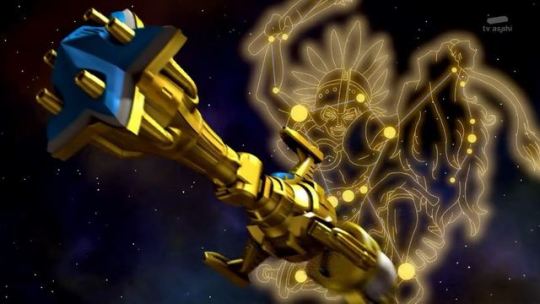

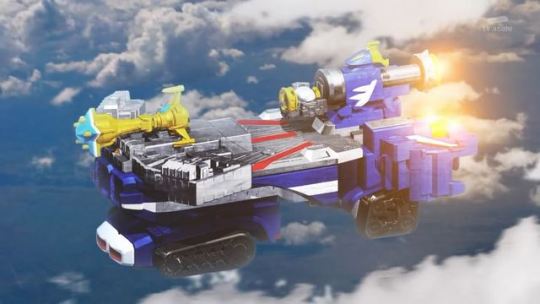


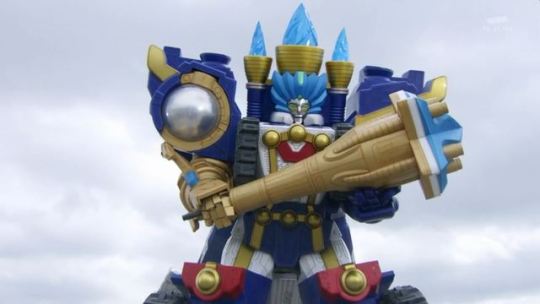
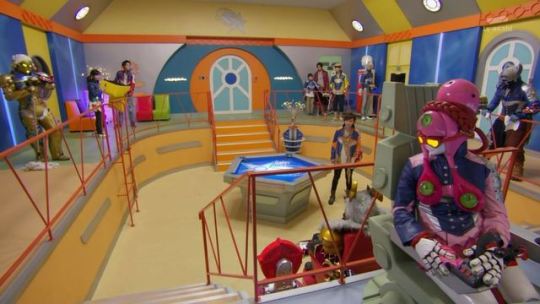
Would you look at that? It's my 1400th post! In Kyuranger episode 33, the team reunites with several old friends, as they welcome a new arsenal to their ranks!
NOTE: In case you somehow missed the notice, this belated recap-view is for the episode that aired on October 8th, 2017. Expect the one for episode 34 that aired a few days ago (on Sunday, October 15th)... soon-ish! ;D
- No intro narration? That feels weird. - With ORION's heroic sacrifice, the Rebellions are now left homeless, and without any necessary transportation. So much for their plan to head out into the Crux System to locate the whereabouts of Don Armage, right? Well... not exactly. - A familiar face teleports her way out of the blue. Yep, Eris returns! Her arrival heralds two major reveals. First, she pretty much confirms that the past has INDEED been altered. Remember how I was kind of concerned how Eris would play a part in the quest for Argo, knowing that Orion has passed away in battle 300 years ago? Turns out, that part of history has been rewritten. She no longer knew the white warrior, and it was none other than Commander Xiao who delivered the Carina Kyu Globe for her safekeeping (as well as entrusting the Vela Kyu Globe to the Vela Tribe, as we'll see later on through his... picture show). Second, in the event of anything bad happening to ORION, Eris has been asked to deliver a special message from Xiao (via the Capricorn Kyu Globe). And it speaks about... Fun fact: Do pay attention to Spada and Raptor's fun reaction when Eris shows up! XD - Legendary Battle Orion Ship!!! Turns out, Orion was building an intergalactic battleship for the past heroes' fight against Jark Matter. As has been teased in the closing scene last week, apparently Xiao took over the development, and completed the process in Orion's sake. It means Xiao was the one who hid the ship as well. - The coordinates that Xiao sends on his message leads Lucky and Tsurugi to... Orion's grave. Aaaawww -_-. At the same time, the others discover a hidden passage underneath the location. Unfortunately, Vice-Shogun Kukuruga is also on the move, tailing our heroes alongside Menaster of the Aries System, Twistler. The Jark Matters don't really have any clue of what the Kyurangers are doing there. Well, at least, until Balance spills the bean. - You see, Twistler unfortunately casts his power on Balance, Hammy, and Spada, that alters and twists their personalities. Balance becomes all classy and sophisticated, Hammy with her hair pulled back (NICE look!) behaves like an old-lady, and Spada is... a rude punk? LOL. This is worse than our regular body-switch trope, because not only they have become a completely different person, they also respond others by doing the opposite of what is being told. So much so, that Naga has to paralyze them using Aries Kyu Globe. - As for the Battle Orion Ship? Well... the 2nd team has already located it. I know what you're thinking... "That was FAST!". Surprise, surprise, the bridge's interior looks exactly like ORION's. Likely due to budget concern and to prevent spoilers ("Episode of Stinger" and web-series "High School Wars" would be released prior to this episode), it still makes sense knowing who is behind its completion. Oh, but there's a bonus item. A cold-sleep capsule is placed in the center, one which Lucky, Kotarou (seriously guys, again?), and Garu jump in to open without any care in the world. - Do we even need to guess who's inside? Of course it's none other than... Xiao himself! He's not even fazed or confused like his 'cold-sleep bro' Tsurugi was (the two even shared the spotlight in the ending sequence), seemingly more than prepared to encounter the Kyuranger's familiar faces. Aaaaawww for sweet reunion! Remember when he and Champ promised to find a way back to the present time? THIS is Xiao's way. Completely ignoring the fact that he's basically putting himself in a dangerous gambling situation. I mean, seriously, if ORION hasn't been destroyed, would the team even search for this ship and find him? Probably NEVER. LOL. And Champ? What about our wrestling robot? I'll get back to this later... - It's not Xiao if he doesn't start blabbing tall-tales right away. Both Raptor's and Naga's reactions to his shenanigans are priceless as usual. But having emotions puts the latter on a different sneer & jeer-ish level that is just... amazing. Even Stinger and Kotarou are tagging along this time as Naga breaks the 4th wall, while Lucky simply doesn't get it. Comedy gold! - Interestingly, Xiao confirms that he's aware of Don Armage's 'revival' as well. Does this imply that the current Armage is in fact the same one that Leo Red Orion had defeated in the past? He also reveals that... Battle Orion Ship can NOT be activated without the Orion Kyu Globe. Which is a problem, because the item could NOT be found in the past. So how will they counter Kukuruga's sudden air strike then? Leave that task to Phoenix Soldier and his Gigant Phoenix. Because while Naga brilliantly manipulates poor-twisted Balance, Hammy, and Spada to fight (what a FUN roll call! How I wish every member is altered), Lucky has a more important task: awakening the Orion Kyu Globe. - That's right, Orion's power has been passed down to Lucky, so he's the only one who can activate it. And it's a moving sequence too, because we get to see Orion again... albeit only in spirit form. Aaaawww, that makes me sad. Hmmm... if his spirit shows up, this confirms that he's DEFINITELY not the new Don Armage. There goes my Darth Vader theory then! LOL. That also means, Lucky's backstory might not be as important nor elaborate as we all presumed... Fun fact: Just like Akyanba, Kukuruga proves that he's also a smart antagonist. Not because he can absorb attacks and returns them. Kukuruga actually stops Leo Red before he can utilize the Supreme Kyu Globe! YIKES. Had Orion's club is not available nearby, he could've been a complete goner... - Orion Voyager debuts! True to its namesake, the golden colored arsenal is shaped like its original owner's weapon. It also activates Battle Orion Ship, with Raptor immediately jumping in to maneuver its first official lift off. The sequence gets better, because when Leo Red Orion boards the Voyager, it transforms the battleship into the team's 4th mecha, the Orion Battler. Sweet homage to ORION, right there! And I'll be damned, it's a sentient robot too. It runs off on its own halfway through battle! - Actual design might be bricky and tacky to look at, with a blue-gold color scheme that seems to be a common/standard of many Super Sentai secondary mecha. But even I have to admit, just like Gigant Phoenix, Orion Battler looks really good and visually impressive in action. I like how the ship's landing platform serves as some kind of coat-tail on the robot's back. Giving off the impression that it's wearing a cape or long coat! One more thing, I've been wondering how any passenger inside the ship would be affected by the transformation, since the battleship basically rotates 90 degrees to stand up. So it's such a pleasant surprise that this episode actually shows what happens to the other Kyurangers on the bridge LOL. A nice minor detail, considering the show could've simply ignored this fact and just ran along with it. - Back to the case of Champ. While the team is busy tidying up their new home, Stinger is quick to address the elephant (or should I say 'bull'? Nice 'flower' arrangement, by the way ;D) in the room: "What happened to Champ?". My oh my, this is one of the downside of having so many members. When one of their own is gone, the others don't immediately take notice! Seriously though, even I somehow had forgotten about him during my first viewing. According to Xiao, Champ put him to cold-sleep, and then went out to locate... Professor Anton. - This raises its own concern, because we all know Anton is a Jark Matter operative. Situation gets more dire, as Kukuruga and Akyanba seem to have discovered Anton's laboratory. One that contains the one and only... Champ!
Overall: This episode was undeniably the Super Sentai love letter to that iconic anime by the title "Uchuu Senkan Yamato". From the shape of the new battleship, the cannon sequence (which is a brilliant follow-up to Xiao's previous remark), down to the tune of its BGM, everything just felt like non-stop homage to the classic series. I have to admit, a 'reveal episode' like this sort of lost its charm upon second viewing. But when I first saw it via stream (without sub), it was genuinely entertaining and more enjoyable to experience. Like I've said above, Orion Battler is an impressive 4th robot. Yet it's far more impressive to know that the writers are addressing trivial and at times minor details that even the most devoted audience would've missed. IMHO, that's the sign of good writing! Next weekTomorrow: Champ Wars - A Luchador Story... PS: If nothing unexpected and incidental happens along the way, recap-view for episode 34 is expected to arrive tomorrow. Same time, same channel!
Episode 33 Score: 8,1 out of 10
Visit THIS LINK to view a continuously updated listing of the Kyutama / Kyu Globes. Last Updated: October 17th, 2017 - Version 3.02. (WARNING: It might contain spoilers for future episodes)
All images are screencaptured from the series, provided by the FanSubber Over-Time. "Uchu Sentai Kyuranger" is produced by TOEI, and airs every Sunday on TV-Asahi. Credits and copyrights belong to their respective owners.
2 notes
·
View notes
Text
#031 Pop Culture Parodies
Superheroes are, of course, a pretty big cultural phenomenon. They’re like celebrities who are also complete blank slates. If you’re doing your job correctly the public should know next to nothing about you. At most they should know your codename, costume and maaaaaybe powers (but if you can somehow keep that a secret all the better.) So that leaves the public with a pretty unique opportunity. They essentially have this mega-famous entity that they can ascribe any personality or backstory that they like. This will, inevitably, lead to countless disparate depictions of heroes across various media. Some will be doing their best to be as factual as possible. Others will be knowing and purposeful parodies. Others still will just be completely making stuff up or giving it their best guess. Now, as a superhero, assuming your (*you’re, come on Zach could you at least try to be a little bit professional what if potential publishers are reading this?) famous enough to achieve this level of fame, how should you deal with these representations of yourselves?
While your knee-jerk reaction to seeing the sitcom produced about your life where, instead of being a valiant crime fighter who has saved the entire world at least three times, you’re depicted as a mild-mannered ice cream man who became a superhero in order to impress ladies and to get discounts at your local stores, might be to shut that whole thing down you should really do your level best to support it. Just think about it, the more information the parody gets incorrect about your actual life the better. It’s only when they accidentally (or through actual thorough investigation) get things right that you need to worry. This is why you need to make sure that never happens. Surreptitiously leak purposely falsified information to the show’s producers. Publicly praise the show for how accurate they were in depicting your day to day life as a high school swim coach. Call up the producer or pay visits to the set under the guise of trying to make things more accurate while actually making things more outlandishly false than the show’s writers would have ever thought to stray. Have them introduce an invisible pet crocodile to the show. Have an entire subplot introduced about your secret love for purple cabbage (which you of course secretly hate and would love for supervillains to do away with). Reveal to them your secret backstory where you’re an orphan who was raised on the moon by sentient moon rocks and that you therefore have no loved ones on Earth for your enemies to get a hold of. All kinds of preposterous stuff that’ll really throw your enemies off the trail.
You can even try to utilize the parody of your life to your benefit. Sell the television studio the rights to air your theme song in order to recoup some of the costs of having a full length theme songs written, recorded, mixed and performed by people using actual jetpacks, which, honestly was just money down the drain if we’re being honest. If merchandise is produced for the show, try demanding royalties or some sort of compensation. Having a parody based on you also gives you a sort of platform to reach the world. After all, the studio would have to be crazy not to take input from the actual hero whose life and name they are utilizing for their own gain. As long as you promise not to sue them or melt them with your face lasers I’m sure they’d be willing to take some of your input. Utilize the show to teach viewers valuable lessons about kindness and tolerance and also as a platform to teach viewers about the different villains who live in the neighborhood (this really only works for local broadcasting. I mean you can do it for a nationally syndicated show but then the whole country will just be very well informed about the criminal populace of the one five to ten block area...)
Another fun thing you can do -since again, these people are stealing your life and so they owe you on some level- is to demand that they let you play a recurring character on the show. Not yourself, you don’t have the time to commit to being the star of the show about your fake life. Just some minor character, like the lawyer or the village chimney sweep. Some small role you can show up and perform every so often when you’re bored. The kicker is that since you obviously can’t just reveal your secret identity to the show’s creators you have to play your small minor lawyer role in full costume. And none of the characters on the show ever comment on it. And the producers really just have to let you just do it because they don’t want to fall victim to your ability to turn human beings into cats with your mind. The producers don’t want to be cats. They want to be producers, that’s why they went to film school in the first place.
While having a pop culture parody version of yourself running around and becoming a household name that may eventually eclipse your actual self in popularity might be embarrassing, remember it’s actually somewhat flattering. If your super-friends make fun of you because there’s a popular web series where you’re a cat who is continuously outsmarted by rodent versions of your most fiendish enemies (except for Hammy Manster aka the notorious Hamster Man, he is, for whatever reason, depicted as a fish,) just remind them that you’re more famous and popular and beloved than them. That ought to put them in their place.
If the parody version of you is like really really offensive and you can’t simply stand by and let it exist, you can always hold a public press conference and slam the parody for getting so many key and intrinsic facts wrong. And then continue to spread different, less offensive lies about yourselves. The key is really to just utilize whatever public platform you can to spread lies about yourself.
Here are some popular parody formats superheroes often find themselves the subjects of:
The Japanese anime/manga where you pilot a giant mecha (this one is pretty harmless and honestly you should hit up your scientist friends to see if you could actually get yourself a giant mecha.)
The sitcom where you’re depicted as more hapless than heroic (see above.)
The children’s show where your image is used to teach valuable lessons (for sure let this one slide, this is clearly a good thing guys.)
The webseries where you rap battle other superheroes and villains (see if you can get them to write you a free theme song.)
The cereal (honestly if you think about, superheroes would make the perfect cereal mascots. They’d fit right in. Tiger on steroids, bird struggling with addiction, klepto-rabbit, phantom detective who can’t get enough of feeding on the souls of criminals.)
The [The following joke has been censored as this is a family blog.]
The documentary that actually put a lot of work into it and so you need to step in to prevent it from being too accurate.
The movie franchise that depicts you as a one-dimensional action hero who spouts cool one liners and causes a lot of uncontained, actually really quite dangerous, explosions.
The social media profiles which make jokes about how you spend your day to day life (a lot of them seem to think you’re rich and sleep til noon every day as if you don’t have a day job or are a productive member of society outside the costume.)
The commercial campaign where you’re depicted as the spokesperson for a variety of products (at the very least you should make sure they pay you for these.)
#how to#superhero#parodies#parody#spoofy#fakes#corporate lies#television shows#sitcoms#ice cream man#the power to turn people into cats with your mind#cats#Hammy Manster#the Hamster Man#fish#mice#giant-mecha#steroid tiger#addiction bird#klepto-rabbit#phantom detective who can't get enough of feeding on the souls of criminals#phantoms#one-dimensional action hero#jetpack choir#theme song
3 notes
·
View notes
Text
Mobile Suit Gundam Is Amazing

I've written about Super Robot Wars twice now. I almost wrote about some of my favorite super robot series this week, instead I'm going to write about a different flavor of giant anime robot; Gundam. Mobile Suit Gundam is the pillar that launched the second half of the giant robot genre; Real Robots. Generally smaller, more military oriented series where the mechs are often tools, stand-ins for the next big step in warfare or otherwise simply used as weapons. They are, generally speaking, machines like tanks or planes. Not vaguely sentient things driven by alien magic or human spirit like in Super Robot shows. But a means to tell a far more typically mundane story, rather than the fantastical means around which the story revolves.
You could, for example, take the sci-fi setting of Mobile Suit Gundam and alter it to make it fit a more realistic one and while some plot points would be lost, the core storyline would be relatively unchanged. You simply can not do the same to something like Mazinger Z, where the sheer fantastic nature of the characters and events -even though the actual physical setting are far more grounded than Gundam's space faring one- are so deeply tied to the narrative that even a small change would render it void.
So, Gundam. What -is- Gundam, then? Well the classic Mobile Suit Gundam is, among other things, a story about how war is bad, how no matter what we do war exists and there will always be people who strive for war, and people who get hurt by it. That one person's just cause is another's atrocity and that ultimately, we can only do what we can to change the future and hope others follow in our footsteps. It covers some fairly unexpected themes for an anime generally expected to entertain kids and market toys. Themes such as PTSD, genocide, war crimes, and the passing of generations.
Gundam's storyline is largely dominated by a war between the Earth Federation, a global government organization, and the Principality of Zeon, an organization of space colony dwelling “spacenoids” dedicated initially to declaring their independence from earth, and ultimately to conquering the earth. This series opens up with this backdrop, with the very first opening narration showing the horrific concept of a “Colony Drop”- wherein the Zeon military forces forcibly knocked a colony out of orbit and sent it crashing down to earth with enough destructive force to annihilate a portion of Australia's land mass. And that's just the narration. The actual plot shows an attack on a colony of innocent civilians for no reason other than the Earth Federation happened to be there. An emergency evacuation that sees a number of civilians, children in particular, drafted into the military to get the one surviving federation ship working or otherwise act as fighter pilots to defend it; and from there the series follows that journey. The one of civilians stuck in a war they didn't want to be part of, had no say in and ultimately didn't even get to refuse as they struggle through attacks from a hostile military force and make their way to earth.
That, the saga of them getting back to earth despite constant Zeon attacks, only make up one fourth of the series. It goes deeper into the struggle of the drafted pilots trying to maintain their grip as they're forced to fight time and time again, to kill other people when they aren't even part of the trained army. The mental toll that killing, and seeing friends and companions die takes on these characters is expressed constantly as the series progresses, not just in the forum of brief emotional breakdowns but in the entire epilogue to the series. The sequels that feature the same characters still show the profound effects this war had on them. No greater example of this is seen than in the most famous two characters of the series Amuro Ray and Char Aznable.
Protagonist Amuro Ray, ace pilot of the titular Gundam, shows up in several later series and each time he expresses his fear and the difficulty he has getting back into the cockpit of a mobile suit. Yet he forces himself into the fight anyway because the alternative is for more innocent lives to die, and he can't bear to live with yet more of that guilty weight on his shoulders. Especially since he feels part of the blame for it, for it is in part his fault that perpetual antagonist and infamous ace pilot Char Aznable survived that initial war. Char, on the other hand, was only galvanized by the events of the war. Initially part of Zeon's army he shows nothing but disdain, even revulsion for the great Zabi family that rules the principality with a leadership, styling themselves after the historical nazi party of earth. Yet his motivations and history slowly reveal themselves over the course of the series and ultimately, despite the intense rivalery between him and Amuro, despite the many battles between them. He escapes. He returns again, and again, and again. Each time with a new dedication to a cause, to his cause, and each time he and Amuro meet they reignite that same old fight in one another, and realize in eachother what they, themselves, lack. For Amuro, he sees that Char has a solid goal and certainty in life, he is always working towards his own ends, he's never lost, never stuck relying on other people to keep him afloat. Char, a man who lived within masks for a lot of his life, meanwhile realizes that Amuro has an identity – a life outside of war and knows he doesn't have anything to go back to. Anything he had, would have or could have is consumed by the charismatic passion that is his desire, and unlike Amuro he can never temper his dreams and just live a normal life.
I could write just about those two for hours and still not have found enough words to describe just how they grow, change and work off one another across three stories but their rivalry influenced manga and anime for decades, and still continues to do so to this day. It is perhaps the ultimate example of two characters who are so utterly, impossibly different colliding head on without either of them being full on good or evil. They are differing ideologies colliding and even the famous ending of their rivalry ends on a unique note. They don't part ways as friends, there is no reconciliation at the last moment. It's two fighters who have a grudging respect for one another on a sheer technical level admitting that no matter what, they will never see, or understand, one another's point of view or even like one another even when forced by circumstance to work together.
I feel that, for all my rambling, sums up what gundam is about at its core. Despite a few missteps here and there, it's not about good or evil. It's not about aliens or who can kill the most people in the coolest ways. It's about characters, and people, and politics. Viewpoints, beliefs and communication. What happens when these things collide, what gives and what fails. Where the breakdowns occur and why. And that is exactly why I think everyone should watch Mobile Suit Gundam. It is, to this date, the best non-super mecha anime out there. It's sequels are good, no doubt, and a lot of other series manage to be great as well. But nothing else manages to hit the same highs and character beats as Gundam.
#nerdshit#I feel really bad because this isn't anywhere near good enough as Gundam deserves#Seriously just watch Mobile Suit Gundam it's amazing#Super Dimensional Fortress Macross is good too
5 notes
·
View notes
Text
Best Anime Available on Netflix 2019
8. Kill La Kill (2013)
1 season, 25 episodes | IMDb: 8/10
If I had to sum up Kill la Kill in two words, they’d be “fashion battle.” Broadly speaking, its story is pretty much beat for beat what you’d expect from a series about a magical teen — developing powers, last-minute turns of the tide — but the specifics are just bonkers enough to keep that from being a weakness Which are some of the best anime on Netflix. At Honnouji Academy, clothes bestow supernatural abilities on their wearer, turning the usual high school hierarchies into a battleground. At the center of it all is transfer student Ryuko Matoi, who’s come to Honnouji in search of her father’s killer. Her sidekick, a sentient sailor outfit, puts her on the level of the school’s student council, allowing her to tussle with them in her quest for the truth. More modest viewers be warned: the series’ focus on clothing also lends itself to a significant amount of fanservice. As the series progresses, the outfits get skimpier and skimpier until there’s barely anything there at all.

Add To Netflix Queue
UFOTABLE
7. Fate/Zero (2011)
2 seasons, 28 episodes | IMDb: 8.3/10
For those looking for darker fare, Fate/Zero should hit the spot. As may be obvious from the fact that the driving event behind the whole series is called “the Fourth Holy Grail War,” it’s heavy stuff. The war is a contest between a select group of mages and their attendant spirits. (The spirits, in one of the series’ strangest gambits, range from Alexander the Great to King Arthur.) They compete for the power of the Grail, which will grant a wish to each of the winning pair. The resulting assortment of competitors doubles as a mix of ideals and morals, and the shifting balance is one of the best aspects of the show. Though there’s a fair amount of comedy mixed in, it’s quite a bleak series, with a death count to rival Game of Thrones and eldritch horrors to contend with, to boot.
Add To Netflix Queue
NETFLIX
6. Castlevania (2017)
1 season, 5 episodes | IMDb: 8/10
Even those unfamiliar with anime are likely to have heard of Castlevania, as the franchise is one of the jewels in Konami’s crown. The anime series is produced by Netflix, and boasts a voice cast including Graham McTavish as Count Dracula, who vows revenge against Wallachia after the death of his wife, and Richard Armitage as Trevor Belmont, the last of a clan of monster hunters, who leads the fight against him. (Matt Frewer also features in the cast, which should be a treat for any fellow Max Headroom enthusiasts.) There’s blood a-plenty, and a nice balance between monster and man as per most gothic horror stories — as well as a somewhat romantic aspect, as Dracula is portrayed as a sympathetic villain. The series is also just gorgeously animated, and with a first season of only four episodes, well worth your time.
Add To Netflix Queue
ANIPLEX OF AMERICA
5. Fullmetal Alchemist (2003)
1 season, 51 episodes | IMDb: 8.6/10
Fullmetal fans and newbies alike are somewhat spoiled for choice when it comes to Netflix’s offerings: Fullmetal Alchemist and Fullmetal Alchemist: Brotherhood are both available on the streaming service, alongside the recent live-action film. But we’re here for anime, so we’ll just discuss the first two. For the purposes of this list, we’re counting both series as one entity, as Fullmetal Alchemist is a seminal property, but not to fear, I’m not about to leave you in the dark. Both Fullmetal Alchemist and Fullmetal Alchemist: Brotherhood are adaptations of the original manga, which tells the story of two brothers, Edward and Alphonse Elric, as they search for the Philosopher’s Stone. In an attempt to bring their mother back to life through alchemy, they’ve been transformed. Edward has lost his leg, and sacrifices his arm as well in order to save Alphonse’s soul, binding it to a suit of armor. The Stone is their ticket to restoration. The more recent Brotherhood hews much more closely to the manga, whereas Fullmetal Alchemist essentially turns into an original series about halfway through. In the end, they complement each other’s strengths and weaknesses, but if you have to pick just one, I’d go for Brotherhood as the “canon” experience.
Add To Netflix Queue
ANIPLEX OF AMERICA
4. Rurouni Kenshin (1996)
3 seasons, 95 episodes | IMDb: 8.5/10
Like most other entries on this list, Rurouni Kenshin was adapted from a manga series (which appeared in the legendary Shōnen Jump magazine). The title refers to its protagonist, Himura Kenshin, a former killing machine who is now committed to helping others to try to atone for his sins. Of course, his love of peace is challenged when it becomes apparent that someone else has assumed his former mantle as an assassin and plans to throw the Meiji Government into chaos. The characters are all well-defined and well-developed, with the biggest hook being the contrast between Kenshin’s apparent happy-go-lucky attitude and vow never to kill again, and what we know him to be capable of due to his reputation. He’s also a walking example of the way the series focuses on period to tell a story rather than using it simply as set dressing: the show takes place during a transition period in Japanese history, and Kenshin is just as much in flux.
Add To Netflix Queue
VIZ MEDIA
3. Inuyasha (2000)
2 seasons, 167 episodes | IMDb: 7.9/10
Inuyasha is the rare franchise that manages to strike a balance between cute and horrifying. To liken it to a current pop culture phenomenon, it’s similar to Outlander, in that its basic plot sounds like something out of a romance novel: a young woman, Kagome, is sent back in time, and must then contend with forces beyond her reckoning, all while getting to know a rambunctious man (well, in this case, half dog-demon), Inuyasha, to whom she seems to be mysteriously bound. There’s plenty of time-travel fluff to go around, but in Inuyasha’s case, it’s augmented by nightmare fuel in the form of a host of demons searching for the magic jewel in Kagome’s possession. The centipede monster in the first episode sets the bar for how unsettling these monsters look, as well as the show’s overall structure as a sort of monster-of-the-week affair. To that end, the show can get a little repetitive, but the cast is uniformly great (including Inuyasha’s antihero brother Sesshomaru, who I think I can confidently say is “the hot one”), and the balance between fun and horror is a rare find.
Add To Netflix Queue
FUNIMATION
2. Attack on Titan (2013)
1 season, 51 episodes | IMDb: 8.8/10
Since the manga began in 2009, Attack on Titan has become something of a cultural sensation. At present, only the first season of the anime, which was produced in 2013, is available on Netflix, but it works on its own. (It’s also notably a series that benefits from being available to binge rather than view doled out in segments, as seeing it all in one fell swoop — or a few swoops — makes its repeated cliffhangers less obvious and thereby more tolerable.) Broadly speaking, it’s almost a mecha series, as the driving force of the plot involves fighting giant creatures (the Titans of the title), an enterprise that only starts to become truly tenable when it transpires that one of the human characters, Eren, is a Titan, himself. The difference is aesthetic: the Titans are awful to look at, as they are basically giant humans with their skin stripped away, and their muscles contorted to look as terrifying as possible. As for why it all works, it ultimately comes down to the focus on the coming-of-age stories and how each character’s arc dials into the anxieties that are part and parcel of growing up and dealing with loss. The series is also fairly brutal when it comes to reflecting the realities of living in what is effectively a war zone, as every character is fair game when it comes to Titan fodder. Equal parts steampunk romp and war story, Attack on Titan is one of the best anime series in the game.
Add To Netflix Queue
VIZ MEDIA
1. Bleach (2004)
3 seasons, 366 episodes | IMDb: 8.2/10 Bleach has it all. It’s stylish as hell, it’s incredibly well-acted, it’s genre-fluid, and on top of that, it’s well-written. Though it starts out fairly simply, it builds and builds, transforming into an epic that more than earns its place in the pantheon of great anime. The story begins when Ichigo Kurasaki, a high schooler capable of seeing ghosts, takes on the duties of a Soul Reaper in order to protect his family. It’s a transition that the show handles beautifully, and does again and again as it progresses. The world of Bleach (and the mythology involved) just keeps getting bigger, without ever falling short, or falling flat. The series is also impossible to peg as one genre or another, as there are elements of almost everything baked in. It’s an epic, and unmissable as such. Creator Tite Kubo’s style is just the cherry on top of the cake.
1 note
·
View note
Note
why do they hate having characters meet so much? do they think it's too awkward? do they think it's boring? did they just lose all their patience after season 1? because i swear if the pilot / rest of season 1 were written the way the writing is in the later seasons, i guarantee nobody would be watching this show, everyone would be too confused and frustrated to bother following it to season 2. unless i'm remembering season 1 incorrectly and it also had cracks but we all gave it a pass then.
“Stories may well be lies, but they are good lies that say true things.” – Neil Gaiman
Let me take my cynical pre-season hat off and answer this seriously, because it’s something I’ve seen when doing critiques for newer writers.
It’s fear.
Almost every writer at some point must deal with the voice that says, what will people think and mom’s gonna be so embarrassed and no one’ll ever invite me to another ice cream social. The censorship weasel dances in your brain, reminding you that these are your ideas, your words, from somewhere inside you. Unless you’ve mocked up a fake co-writer to blame all the gross (or steamy or violent) parts on, the weasel is terrified that people are gonna look at you and judge you for the world you created.
Next, add on genre insecurities. I know successful published writers who still get asked, “when will you write a real story?” as though a year of sweat and tears writing urban fantasy isn’t as ‘real’ as literary pap about a middle-aged professor lusting after a student. Or friends with amazing backlists in romance who’ve always written with a pseudonym, because romance is just fluff, what do you mean you do actual research, you can’t really take this stuff seriously. The vast majority of American animation (esp toy-pushing series meant for saturday morning) is another discredited genre.
America is a cynical, corrupt, culture. You can see it all over our popular entertainment that treats sincerity as the kiss of death. So first you have to fight your way through the censorship weasels, and next grow the tough skin against the genre insults, and assuming you survive those, you’ve still got an uphill battle against a culture that will mock genuine feeling in anything it sees as less worthy: younger audiences, subaltern or marginalized voices, or pop-culture modes (comics, pulp fiction).
That fear becomes justification.
It’s just for kids, anyway. No one’s going to remember this in ten years. We’re not writing War and Peace here. Don’t put too much effort in, or people will think you take this seriously. Skip that scene, it’s too heavy. Just gloss over those parts, no one will care anyway. It’s just a story. It doesn’t matter.
There is little more heartbreaking to me, as a writer, to read or watch someone’s story and catch the traces where they told themselves: it’s just a story, it doesn’t matter. And I often find myself infuriated on their behalf that they had no one – whether editor, or boss, or producer – to remind them that there is no such thing as ‘just a story’, that every story should matter, in its own way.
There’s a quote from Tim Hedrick that gave me a pretty good idea that I’d be seeing those cracks, inevitably, in VLD:
I think that comedy does not undercut drama. I think it sets it up and makes things even more dramatic. When you’re doing a show like Voltron, on the face of it is just so ridiculous that you have five robot lions that create one giant robot and you’re fighting intergalactic forces. If you play that just straight it ends up being campy.
Except that comedy does undercut drama; as Carol Burnett put it, comedy is tragedy plus time. In other words, comedy distances you. It doesn’t heighten drama, it reduces it, like when it lets you laugh at what scared you. Sometimes it’s good to have a little humor to let out the air, but you have to use it wisely, and very sparingly.
However, if you’re afraid of that drama, the justification in the quote above would sound awfully sweet. Plus it has the nice byproduct of winking at the audience: see, see, we’re not really taking this seriously. We know it’s ridiculous, don’t worry, we know this’ll never win a Nobel Prize in Literature. We know it’s cheesy, campy, trite, corny.
Here’s the thing, though: so what? Some of the most amazing stories are, on their face, somewhat ridiculous and yet also incredibly moving.
Two kids from an underground city find a drill that lets them control and combine robots to defend themselves against sentient beasts in huge mecha. A woman is the great-great-granddaughter of a famous gunslinger and must undo a curse on the family line. Two brothers try to get back their bodies in a world where transmutation is real and so are homunculus and human-animal chimeras. A kid is bitten by a radioactive spider and develops superpowers. Five pilots fly massive machines to attack earth and get caught in a multi-factional war they never expected to live long enough to see. A cheerleader is chosen as next in a long line of vampire slayers.
Five lions that combine into one giant mecha are no more ridiculous than a single man shooting a single arrow through a dragon’s chest and taking it down. Or a kid groomed through violence and abuse into becoming a skilled killing-machine gamer. Hell, isn’t it just as ridiculous to have a character obsessed with some crazed whale? Or a girl who meets the mountain spirit near her new rural home? Or four siblings who go through a wardrobe and end up in fairytale land?
If you play it straight – as all of the above were – it doesn’t end up being campy. It ends up being earnest. It will be a story that refuses to bend a knee to the censorship weasels or the genre insults. But earnest is a step away from sincere, and that’s just shy of taking storytelling seriously, and hello, weasels.
Fear tells the writer: don’t believe in the story’s world, or the characters, or the story itself. Safer to keep it at a distance, make it something to laugh at, rather than honest enough to be wept over. And when you listen to that fear, you skip those scenes that really matter, because it’s just a story, anyway.
When the writer is so afraid of telling an honest story that they refuse to see its truths – let alone believe in such truths and accept they matter – what is there to entice a reader to believe, in the writers’ stead?
25 notes
·
View notes
Text
Donyatsu is a Sweet, Unexpected Surprise
Donuts. Donuts never change.
The irrelevant and strange post-apocalyptic world of Yusuke Kozaki’s Donyatsu, a silly slice-of-life series about pastry-inspired critters, is a welcomed and eccentric break from reality. Adapted into a 12-episode original net animation series (ONA) by studio Gathering from Kozaki’s manga in 2013, Donyatsu provides a seemingly standard post-apocalyptic setting with a sweet slice-of-life twist. It dares ask the question—can the end of the world be funny? Can it be about cats and delicious treats while the world burns?
Kozaki’s work has mostly been seen in anime and video game character design—most notably in the Fire Emblem and Pokémon franchises, BBK/BRNK, and Speed Grapher. After debuting in Young Gangan in 2011, the Donyatsu manga soon garnered a cult following for its unique combination of post-apocalyptic story with slice-of-life comedy. I first discovered the series back in 2015 and considered it something of a “hidden gem” at the time through the short net anime. However, I quickly realized that these handful of episodes provided just a glimpse of what the full and bizarre Donyatsu world had to offer. The main appeal of Donyatsu is that it obviously has no large overarching plot—in fact, most of its characters struggle to achieve more than sleeping and eating. Compared to other post-apocalyptic series, the worst of the final blow has already landed and there’s no going back. It's a surprisingly laid-back, empty world.
Donyatsu and Bagel making friends
Black Comedy With Sugar On Top
Our hero, Donyatsu, wakes up one day to realize he is now an adorable chocolate donut-shaped cat. Has he been transformed for a human? It’s not clear. The Shibuya streets might be empty, but in lieu of humans are a handful of new friends: Bagel, a basic but stern brown bagel cat; Rollnya, a sweet (you guessed it) roll-themed cat; Baum Cougar, the baumkuchen cat who is also a genius internet hacker; and Kumacaron, the pink macaron bear who loves the in-world "Dragon Fall" manga. There’s also a military squadron of mice who may or may not actually be a threat. Is anyone here terrified by what appears to be a nameless catastrophy? Or civilization as we know it coming to a halt? No, Donyatsu and pals are too busy playing shiritori with a giant space robot instead. Even Baum Cougar, the most prepared of the kitties, is a jab at stereotypical “preppers” and nerds who spend too much time meticulously planning out end-of-world survival scenarios. Will he be their savior in the end times? Well, no. In fact, he’s sort of a creep. They’re all jerks.
Ironically, despite being friends, Donyatsu and pals all kinda hate each other. Unlike other laid-back slice-of-life series, these characters truly have no choice but to involuntarily put up with each other. Donyatsu is bullied by the others in almost every episode. At first it’s a bit odd, since these characters don’t typically seem like the kind to be mean or spiteful. In the end, it’s Donyatsu himself who ends up being the butt of jokes, who personally admits that maybe he isn’t quite as funny or smart as the others. At first I thought, “well, that’s a little sad,” but over time I came to love it—especially after reading the manga, where Kozaki’s sick and silly sense of humor truly shines. Donyatsu is meant to make you feel good, but maybe at these cute animals' expense.
Rudeness without reason is the point. Despite it being the end of the world, despite being adorable pastry animals, Donyatsu and his friends are still all undeniably, selfishly human. Think of house cats. You think they care when they knock over your priceless, priceless treasures? Hell no. Don’t let the cute demeanor fool you. They are cruel, cruel folks.
The mice stab Donyatsu with a fork. Ouch.
When I first showed Donyatsu to a friend five years ago, they said it reminded them of the cartoon Adventure Time—which has been confirmed by its creator Pendleton Ward to also be set in a post-apocalyptic world. When I thought of how strange and illogical those characters acted, I realized I knew why Donyatsu appealed so much to me. What makes Donyatsu’s cutesy, over-the-top post-apocalyptic setting so appealing despite the dreary background story? It might be the humor of cognitive dissonance, that situations like devastated cities and the destruction of human civilization aren’t inherently meant to be “funny” unless you’re very jaded. While the Donyatsu anime itself doesn't fully explore these themes compared to the source material, the understanding that these wacky adventures all take places after a catastrophic, humanity-ending event adds an extra layer to an already strange concept. Cats can’t think that far ahead until there’s a yummy snack at the other end. But us viewers? Their situation really is hard to stomach.
One Donyatsu skit involves Kumacaron reading manga out loud while Donyatsu and Bagel are cooped up in Baum Cougar’s safehouse. Familiarity soon breeds contempt, and in this case just enough contempt for Bagel to smack Kumacaron silly after reading all the over-the-top shounen manga dialogue. In the original manga, the group goes to a supermarket in search of canned goods, but quickly devolves into toilet humor and a strategic joke about karinto cookies (look them up). There's no dramatic build-up or sense of urgency to seek out real survival. It's not that Donyatsu and friends don't care—they're lucky enough to not know they should care. They get fed up with each other, bully and harass, all normally high-stakes, dramatic moments when looking at your last handful of post-apocalyptic survivors, but here it’s just good old-fashioned slapstick.
Donyatsu and Bagel
A returning group of characters, the mice, meanwhile, are framed as villains. The joke is, of course, they’re tiny mice with military helmets with forks as their weapons. At first, they seem like they might pose a challenge to Donyatsu, but surprisingly (and albeit with some body horror-esque realizations about how donut cat physiology works…) Donyatsu’s flesh heals itself. You literally can’t eat donut cats. It turns out they are maaaybe immortal. In a perfect world, Donyatsu could let the mice eat him and then just regenerate over a few days—but that’s missing the point entirely. Donyatsu and friends aren’t that preoccupied with “survival” and “consuming” like the mice, so the thought likely has never crossed their mind. They just wanna hang out. In volume two of the manga, Bagel wonders how long they have until they all run out of food and starve to death. It’s a briefly sobering moment that acknowledges these characters might have an actual life expectancy. Everyone is deathly quiet, wondering when they might die. And then it’s immediately back to jokes. There are no hard answers. Can they really live forever? What happens if they eat other donut cats? Who knows.
Sweet Slice-of-Apocalyptic-Life
Under the unthreatening frosted and chocolate-dipped exterior is a perfectly blended appreciation for black comedy. Donyatsu is a love-letter to the special kind of dark, but not too dark humor that comes from when you mix idiosyncratic characters with a surreal take on the typical post-apocalyptic setting. This isn’t a story about surviving the end times—it’s about passing the time and making the most out of what should be scary because you're bored, hungry, and stuck in a room with someone narrating an entire shonen manga back-to-front with sound-effects.
It’s no secret that post-apocalyptic stories have been a solid trend in anime and manga for decades. However, there’s now been a recent trend of shows catering toward unlikely fans of the slice-of-life genre. Shows such as Sound of the Sky, Humanity Has Declined—and even Kemono Friends—have all played with the concept of slow, easy-going life amidst the end of the world. In some cases, the fall of humanity is more obvious, especially when your characters are, well, actually human and not adorable sentient food-animals. This "cutesy apocalypse" is an unexpected offshoot of what is universally recognized as a depressing and tense genre full of peril and high-stakes stories. They’re optimistic at the end of the day, and so is Donyatsu.
The over-exaggerated pastels and puns of a surreal setting after the end is appealing, if not a good set-up for an ironic punchline. Donyatsu doesn’t use its post-apocalyptic setting as a “gotcha” or shocking twist, but rather embraces it as its entire backbone to ask whether or not people would still get in arguments about fighting game tactics and snacks (the answer: yes). As short and sweet as it is, Donyatsu is an unexpected source of comfort, and a reassurance that weirdness always wins out in the end. If you want a fun escape with tons of cute animals doing sometimes not-so-cute-and-pleasant things, it’s undeniably worth your time.
Have you explored the post-apocalyptic landscape of Donyatsu? Let us know your favorite light-hearted shows with dark backstories in the comments—you might be surprised how many there are!
------
Blake P. is a writer who loves his cat. He likes old mecha anime, computer games, books, and black coffee. His twitter is @_dispossessed. His bylines include Fanbyte, VRV, Unwinnable, and more.
Do you love writing? Do you love anime? If you have an idea for a features story, pitch it to Crunchyroll Features!
0 notes